Wildlife after dark
Find out what your nocturnal nature neighbours do after dusk
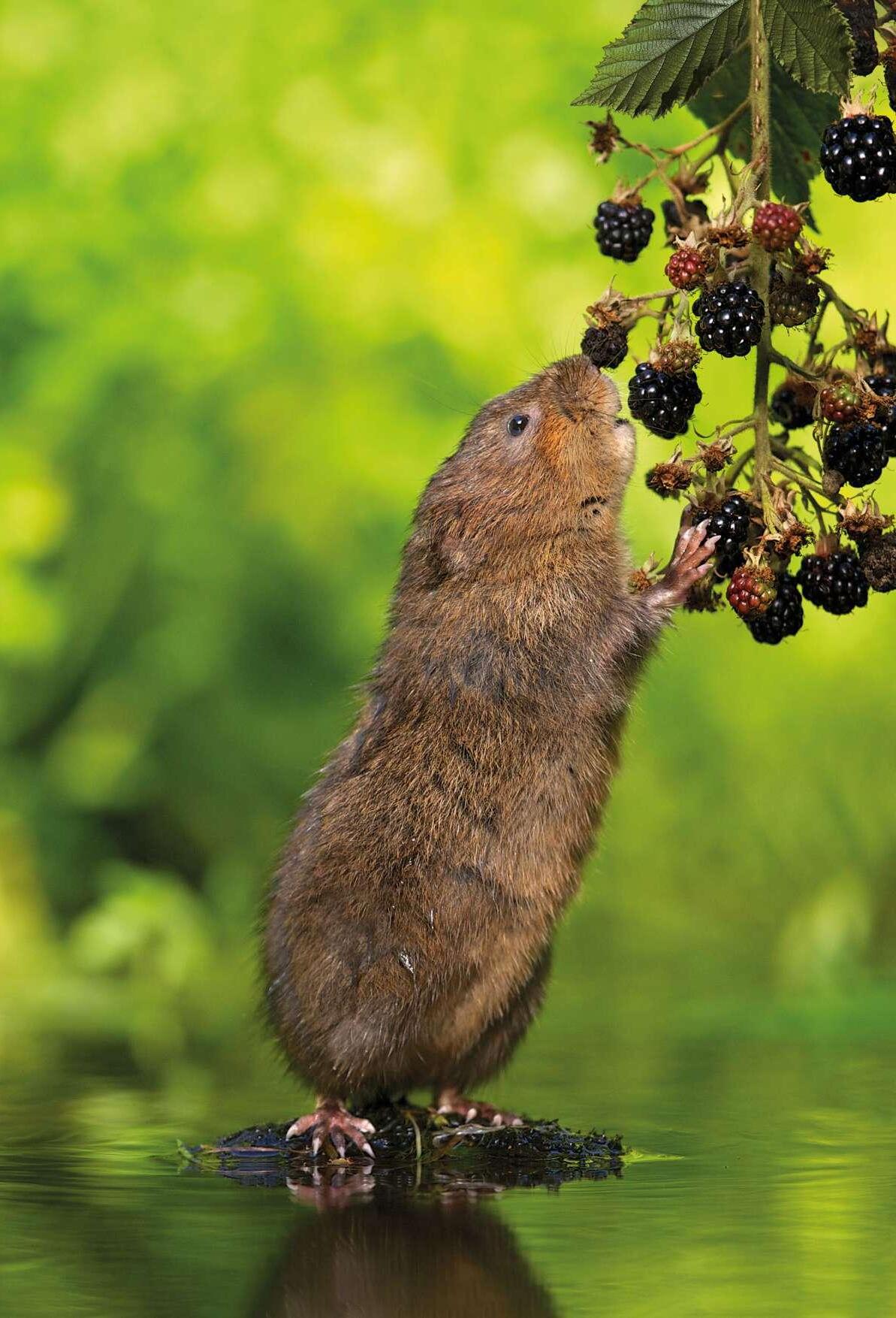
Insector Gadget
Get clued up on the difference between bees and wasps
Butterflies to spot this summer
Page 16
Reconnecting
Restoring fish migration networks across our freshwater landscape
Page 50
Discover Wildlife Explore Nature in Essex
The magazine for Essex Wildlife Trust members Issue 123 | Summer 2023
Page 44
Page 38

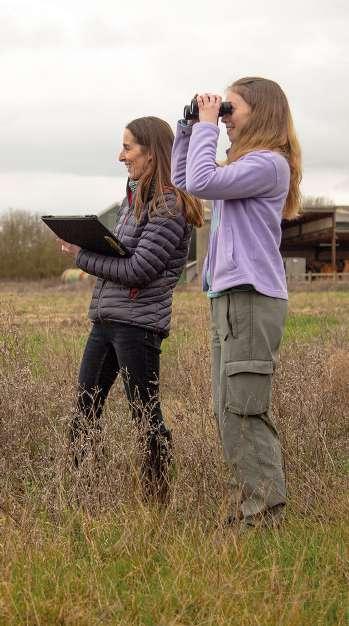

At Essex Ecology,we deliver effective ecological solutions that achieve the best outcome for our clients and for wildlife. Find out how we can help your next project: 01621 862986 | www.EssexEcology.co.uk Essex Ecology is a subsidiary company of Essex Wildlife Trust Limited. Company Reg No. 02853947 England and Wales VAT Registered No. 945 7459 77 Scan for more
Welcome
Any passionate conservationist will know that if you care about the natural world, you indirectly sign up to an ongoing battle to fight to protect that natural heritage, for future generations. I’ve learnt throughout my conservation career that you must be totally committed, perseverant, forthright, stubborn at times and increasingly outspoken. You can’t give up the fight at the first knock-back and finding things that fuel your resilience is essential.
I heard recently of the very sad passing of one of our founder members, who was just short of fifty years of incredible membership of the Trust. I found this so incredibly humbling to hear of her stoic commitment to the Trust and I was so inspired by her story. To me, this individual was a wonderful testament to everything that we stand for and everything that we will continue to fight for.
In my mind, it shouldn’t be a battle. It dismays me greatly that human beings don’t value the natural world and it frustrates me deeply when decision makers don’t have the foresight to show real leadership for our children’s future. But this great Trust and its incredible members will continue to be unwavering in our pursuit of a Wilder Essex. As a collective voice, we will never fall silent.
Dr. Andrew Impey Chief Executive Officer
@essexwildlifetrust
@EssexWildlife
EssexWildlife
Trust www.essexwt.org.uk
We
your help!
Fundraise for the Trust
From hosting a delicious bake sale to tackling a hefty hike, you can help create a Wilder Essex by fundraising for Essex Wildlife Trust. Download your free toolkit to help you start your fundraising journey at www.essexwt.org.uk/fundraise
Share our Shores
MEET THE WILD TEAM
Editor-in-Chief Emily McParland
Executive Editor
Rich Yates
No. 123 Summer 2023 ISSN 2756-0066
All enquiries to: Essex Wildlife Trust, Abbotts Hall, Great Wigborough, Colchester, Essex, CO5 7RZ
T 01621 862960
E enquiries@essexwt.org.uk www.essexwt.org.uk
Reg Charity No. 210065
VAT Reg No. 945745977
638666 England The Trust is a corporate member of The Wildlife Trusts. The views expressed in this publication are not necessarily those of the Trustees of Essex Wildlife Trust. We are the county’s leading conservation charity, committed to protecting wildlife and inspiring a lifelong love of nature. We manage nature reserves and discovery parks across the county, providing outstanding outdoor learning and preserving places of wonder. Founded in 1959 by volunteers, we protect over 100 sites across Essex and are supported by 40,000 members. Our climate is in crisis and nature needs our help. Together we can protect the future. Join us. We are
one of the largest Trusts that work together throughout the British Isles as The Wildlife Trusts.

Editors
Bailey Tait and Lauren Cosson
Editorial Assistants Charlotte Mugliston and Francesca Chantry
Art Director Lottie Hall
Designer
You can help keep beach-nesting birds safe this summer by giving them the space to hatch, feed and rest on Essex’s beaches. Find out more at www.essexwt.org.uk/share-our-shores
Listen to The Wildlife Explorer
If you like podcasts full of fun facts, inspirational guests and wild adventures, then The Wildlife Explorer podcast is for you! Take a walk or listen on your commute to work - our brand new season is out now on Apple Podcasts, Spotify and other podcast platforms.
Advertising Jamie Watt
To advertise in WILD magazine contact Jamie on JamieW2@essexwt.org.uk
Printing The DS Group
Tasha Mound WILD magazine includes adverts from third-parties. However, services offered by advertisers are not specifically endorsed by Essex Wildlife Trust. The income from advertisements goes towards the cost of printing and postage. This means that more of your membership donation goes directly towards conservation. Adverts must conform to the British Code of Advertising Practice.
Copyright © Essex Wildlife Trust 2023
Volunteer with us
We really hope you enjoy receiving your magazine. If, however, you would prefer to convert to our digital-only Green Membership, please contact the Membership Office on 01621 862964 or by email at members@essexwt.org.uk. We will be delighted to help you manage how we communicate with you.
Welcome 3 WILD Summer 2023 |
Issue 123 | Summer 2023
‘a wonderful testament to everything that we stand for and everything that we will continue to fight for.’
need
The Trust relies on an incredible team of volunteers to help us do more for wildlife. Whatever your skillset, we have an opportunity for you! Find out more about volunteering at www.essexwt.org.uk/volunteer Front cover photo: Water vole: bridgephotography
Join the conversation:
Essex Wildlife Trust
@essexwildlifetrust Essex Wildlife
WILD is the magazine of Essex Wildlife Trust and is published four times a year: Spring, Summer, Autumn and Winter
Company Reg No.
wetlands Restoring our
Find out how Blue House Farm’s new wetland is supporting vulnerable breeding birds.

Page 32

| 4 WILD Summer 2023
WHAT’S INSIDE

6 YOUR WILD ESSEX
Your breathtaking photos of Essex’s incredible wildlife and natural landscapes.
8 TRUST NEWS
Updates from throughout the Trust on our work to protect wildlife and inspire a lifelong love of nature.
14 inspiring the next generation
Essex Wildlife Trust Ambassador and photographer, Alfie Bowen, shares how he is encouraging others to help protect our wildlife.

40 Secret ponds
Discover the wonderful species that thrive in and around a pond.
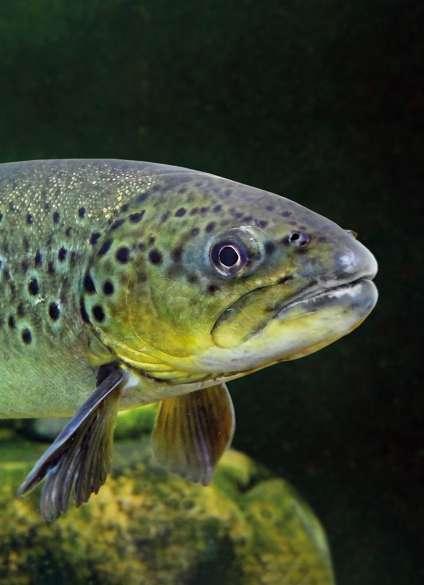
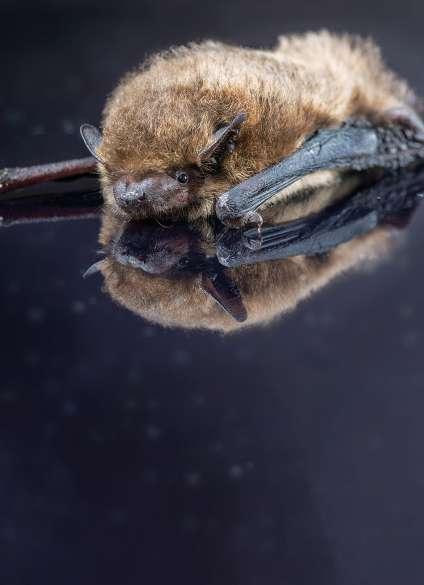

44 Summer events and spectacles
Spend your summer at wild events and experiencing stunning spectacles - don’t forget your hat and suncream!
48 Leading the way
How to ensure you’re leaving a positive impact when visiting a nature reserve.
50 Bees and wasps
The UK has over 7,000 wasp species and over 280 bee species. Learn how to spot the difference between these buzzy beasts.
52 Time Tunnel
We travel back in time to the year 1970 to see what was happening at the Trust.
54 Wildlife crossword
Test your knowledge of the natural world with our fun wildlife crossword.
16 River Connections
Discover the projects helping to connect up our rivers and the network of people protecting them.
24 Under the spotlight:
Hanningfield reservoir Nature Discovery Park
Created as a reservoir in 1951 and a nature reserve in 1992, Hanningfield is now designated as a Site of Special Scientific Interest (SSSI) for wildfowl, provides a safe haven for numerous bat species, and has accessible trails for everyone.
38 Wildlife at night
Discover what wildlife wakes up around us after the sun goes down.
Badger photo: Russell Savory
Badger photo: bearacreativestock.adobe.com
Brown trout: Kletrstock.adobe.com
Summer brings with it singing birds, vibrant wildflowers and beautiful butterfly sightings. Our members and supporters have made the most of capturing spring’s wildlife spectacles! Feast your eyes on our selection of wildlife snaps submitted by you over the past few months.
sure you get my good side’ -

If you would like to feature in our next edition of WILD, please email your favourite images of Essex’s wildlife and wild places to magazine@essexwt.org.uk or tag Essex Wildlife Trust on social media.
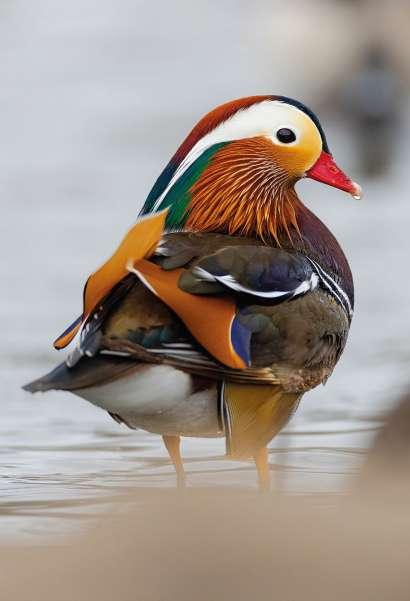


6 WILD Summer 2023 | Your Wild Essex
This is a ‘dam’ good photo of one of the four new beavers released at Spains Hall Estate by Colin Shead, @ColinShead2.
Why hare-lo there! This soggy hare is waving hello to photographer Waldo Ferris, @WaldoFerris
This colourful mandarin isn’t ducking away from the camera. Photographed by M.R.Buckley, @mbuckleywildlifephotography
‘Make
this cormorant is posing for photographer Shiela Winwright, @mum385.
‘Owl about this for an action shot?’ We love this

I’ve got my eye on you! A smooth newt poses for Oli
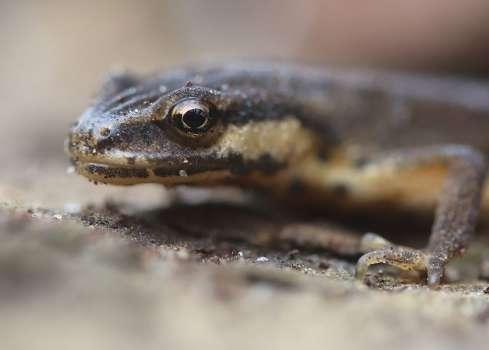
#essexwildlifetrust
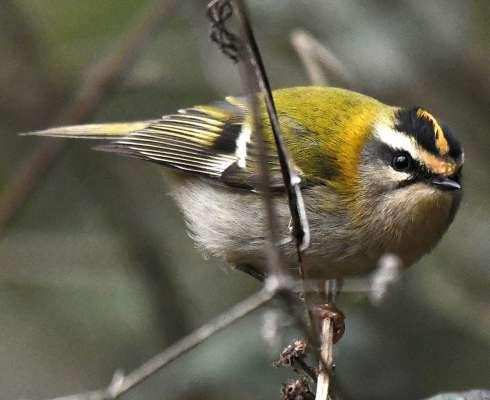

7 WILD Summer 2023 | Your Wild Essex
photo of a barn owl snapped by photographer Will Brown, @wildlifehappens
C, @OliMcwildlife
It is ‘nutty’ how cute this bank vole is! Spotted by Elizabeth Clare, @Elizabeth_Clare_Photography Britain’s second smallest bird, the dazzling firecrest, spotted at Wrabness nature reserve with its famous yellow hair-stripe by Mike O’Hanlon, @YellowShriker.
Stories and news from throughout the Trust on our work to protect wildlife and inspire a lifelong love of nature across Essex. Written by our staff, volunteers and members of our Local Groups.
Breeding bird surveys



Stuart Brooker Lead Reserves Ecologist

Each spring, with the help of Trust staff and volunteers, we carry out breeding bird surveys on our reserves. The surveys require walking a fixed route around a reserve early in the morning, and recording all birds seen and heard along the way. Approximate locations of birds are noted, which will enable us to visualise where birds occur within reserves and inform reserve management. Each reserve is visited in early spring (1 April to 15 May) and again later in the season (16 May to 30 June). This captures more resident and migratory species present on reserves.
Notable species spotted early in the season have included lesser spotted woodpecker at Pheasanthouse Farm, nightingale at Abberton and Wrabness, an early arriving cuckoo recorded on 9 April at Howlands Marsh, and grasshopper warbler, so-called for its insect-like reeling song, at Roding Valley Meadows. However, records of our more common species are equally important, and their numbers can reveal much about the health and quality of habitat on our reserves.
Trust news 8 WILD Summer 2023 |
Red campion: Vaughn Matthews
Grasshopper warbler photo: Chris Gomersall/2020VISION
Cuckoo photo: Dean Eades
Lesser spotted woodpecker photo: Stefan Johansson
New bird feeder webcam
 Lauren Cosson Communications Officer
Lauren Cosson Communications Officer
The Trust’s suite of wildlife webcams has grown, helping people to experience all sorts of wildlife up close. Our new bird feeder webcam features Hanningfield Reservoir’s peaceful water in the background, as the webcam is located at our Nature Discovery Centre. On a typical day, look out for blue tits, great tits, coal tits, long-tailed tits, nuthatch, great spotted woodpecker and, occasionally, a sparrowhawk. By night, you might spot a pipistrelle bat or two swooping amongst the trees, hunting for insects to feed on. Watch the webcam now: www.essexwt.org.uk/ bird-feeder-webcam
Using mapping to assess storm impact
Kate Hayward Biological Records Centre Mapping Assistant
We have been developing a rapid damage assessment tool which uses our mapping software and data to assess storm damage to trees on the boundaries of our nature reserves. With the unpredictability of our climate, we are now getting very strong storms, such as Storm Eunice in February last year. Using highlighted high-risk zones, our wardens and staff can go direct to these areas to assess the damage and inform external bodies such as utility companies, homeowners, rail and road companies. We can watch this live and ensure appropriate resources are sent to our reserves to make the area safe. Mapping our reserves and wildlife over the years helps build up more powerful data that will ensure we are maximising the benefit for wildlife, and the people who enjoy them.
Fingringhoe’s first art trail


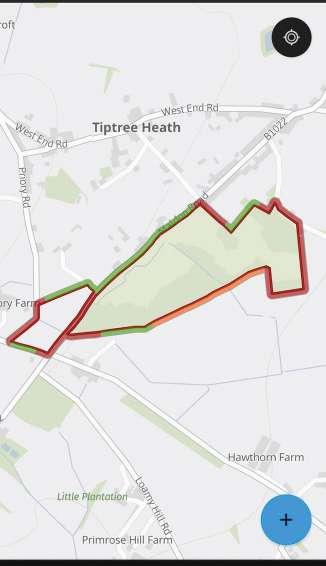
Verity Hales Site Manager
In collaboration with Colchester Arts Society, Fingringhoe Wick Nature Discovery Park is hosting its first sculpture trail. The trail’s name, ‘Track Markers’ is taken from Robert MacFarlane’s book ‘The Old Ways’:

“Humans are animals and like all animals we leave tracks as we walk: signs of passage made in snow, sand, mud, grass, dew, earth or moss […] We easily forget that we are track-markers, though, because most of our journeys now occur on asphalt and concrete.”
Launched on 1 April, the trail will be displayed until the end of September, with most pieces available to purchase thereafter. Wander around the reserve and admire the 21 sculptures on display, created by local artists, often inspired by nature – if not the reserve itself. Works encompass everything from concrete, steel and digital aluminium to framing nature and neon text installations. The trail is free (a £3 entry donation is suggested) and can be explored on foot or by mobility scooter.
9 WILD Summer 2023 | Trust news
Nuthatch photo: Tom Hibbert
Training for Wilder Communities
Danielle Carbott Wilder Communities Manager
For 2023, we have been offering individuals, communities, groups and councils that are part of Team Wilder free access to a programme of workshops and webinars. Six topics are being covered from April to September including Preserve Ponds, Survey for Success, Benefit Bugs, More Meadows, Greener Gardens and Transform with Trees. We can’t wait to share further knowledge with our Team Wilder champions, who are working on making each part of the county wilder. Find out more about becoming a part of Team Wilder at www.essexwt.org.uk/team-wilder
The Essex BioBlitz
 Bailey Tait Campaigns & Advocacy Manager
Bailey Tait Campaigns & Advocacy Manager
Last year, the Trust partnered with the University of Essex to launch a county-wide citizen science survey that will contribute to important climate change research. Across the 2022 season, we had an incredible 17,500 records submitted by supporters.
The data will be collected each year from April to the end of September and will help build up a picture of how climate change is impacting our local flora. The more observations submitted, the more we will be able to learn.


You do not need to be an expert in identifying wildflowers to take part. Download the free iNaturalist app and take photos of wildflowers in bloom all summer long. Learn more at www.essexwt.org.uk/essex-bioblitz
Nextdoor Nature
Adam Nixon & Helen Innes Wilder Community Organisers
The Nextdoor Nature project is flourishing in South and North Essex, where we are working with specific communities across Clacton, Jaywick, Thurrock and Basildon. In the south of the county, Helen has had several meetings with new community groups in Aveley and Chadwell and they are beginning to plan conservation actions in their area. Taking advantage of the warmer weather this spring, she has also held a number of community events including little picks and outdoor gatherings.
In the north, Adam has teamed up with Jaywick Martello Tower to create a nature booklet on the wildlife that can be spotted in Jaywick. Work has taken place in Crossways Park to clean out and maintain the pond with great success. Working with UnSealed, the packaging-free shop in Clacton, there has been huge progress with a fruit tree project, aiming to bring up to 30 fruit trees into the centre of town with the hope of planting this autumn.
If you wish to hear more about the work Adam and Helen are doing, listen to episodes 55 and 62 of the Essex by the Sea podcast. If you live in Clacton, Jaywick, Basildon or Thurrock and wish to chat about nature or wildlife in your area, please get in touch at NextdoorNature@essexwt.org.uk

Trust news 10 WILD Summer 2023 |
Stag beetle photo: Terry Whittaker/2020VISION
Forest School Training at Langdon

 Karen McKay Education and Community Officer
Karen McKay Education and Community Officer
Eight hardy teachers and nursery staff joined us in February for the first Level 3 Forest School Leader course to be run at Langdon Nature Discovery Park. Our Wilder Learning Officers, Karen McKay and Lucy Lofthouse, are currently undergoing their own training with Cambium Sustainable to become accredited Level 4 trainers, delivering this course as part of that qualification.
Over two weeks, the intrepid trainees explored learning and development in the natural environment, management of woodland ecosystems and developing practical skills such as fire lighting, tying knots, and using tools. The Forest School learner-led, play-based ethos is applied to the training with learners building skills at their own pace and exploring the woodland in a playful way each day, coming together as a community to support each other over nine months as they complete their portfolio. If you would like to join us for the next course, find out more on www.essexwt.org.uk/forest-school-leader
Eve’s 87 adventures
Michelle Shepherd Supporter Development Officer

On 31 December, Essex Wildlife Trust volunteer Eve Ingram set herself a challenge – to explore every one of our reserves in 2023. Not one to shy away from a challenge, Eve and her family have made it their mission to not only visit every single one of these amazing spaces, but to raise vital funds for their local wildlife at the same time. If you would like to support Eve and her family on their mission, visit www.JustGiving.com/ fundraising/eve-ingram1
Tree planting to recognise corporate centenary
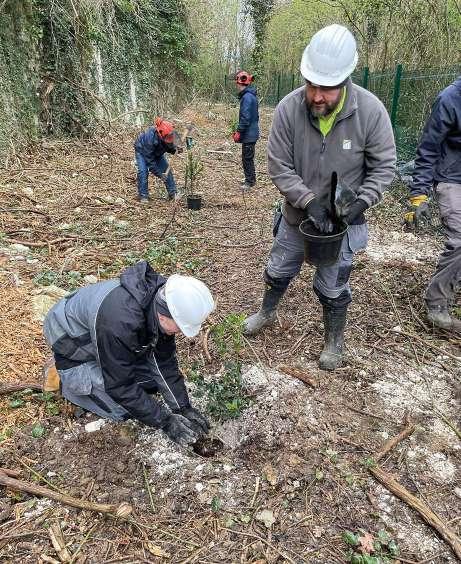 Karen Dixon Corporate Coordinator
Karen Dixon Corporate Coordinator
H W Wilson Ltd have been corporate members since 2013 and last year upgraded to gold membership. To mark the years leading up to their centenary as a limited company, 100 trees will be planted in 2023, their 93rd year. They began planting trees on 20 February, their anniversary, in 2020 and will continue to do this each year until 2030. So far, 400 trees have been planted, with 600 more to come. This year, they have joined forces with Essex Wildlife Trust and Thames Chase and will be working with our Ranger at Chafford Nature Discovery Park, Dean Williams. to provide native trees sited to shaded areas, such as yew andbeech, all sourced in the UK to repopulate an area of Chafford Hundred Gorge, not far from their Ockendon Head Office.
As well as being one of our wonderful volunteers, Eve is also a budding wildlife photographer and her beautiful images – along with updates on how the challenge is progressing – can be found on her Instagram page @stay-wild-hurricane We are wishing Eve and her family loads of luck in the coming months – and look forward to catching up with them later in the year.
11 WILD Summer 2023 | Trust news
News from Brentwood & Billericay Local Group
Graham Clegg Chair
Our talk in March by Sandra Lawrence on the horticulturist Ellen Willmott of Warley Place proved very popular. The speaker was able to draw on the research in her new book, “Miss Willmott’s Ghosts”. It was perhaps less a talk and more a theatrical performance, which was very entertaining. The Warley Place Spring Bulb Spectacular organised by Volunteer Warden, Mick Hedges, and Audrey McCarthy was again successful this year, despite the cold and wet weather.
In June and July, we have organised walks to the Lea Valley and Wat Tyler Country Park, and a talk on the wonders of Epping Forest. Details are on the Trust’s website and the Local Group Facebook page.
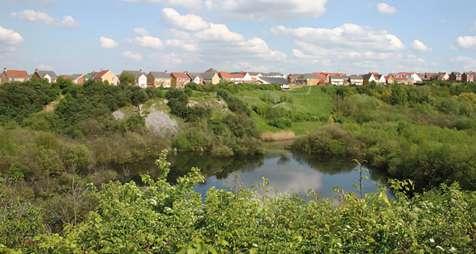

News from chelmsford Local Group
Sue McClellan Secretary
We’re resuming face to face evening talks commencing 27 September at 7.30pm with a presentation by Rich Yates, the Trust’s Director of Engagement, titled ‘Essex Wildlife Trust, then and now: 1951 to 2023’. Please join us at the Great Baddow Millennium Community Centre, Recreation Ground, Baddow Road, CM2 9RL. We also look forward to seeing you on our monthly guided walks throughout the summer, visit the Trust’s website or contact Sue via suem@idnet.com for details.

News from Colchester Local Group
Tracey Kinns Treasurer
Despite the clocks springing forward, the weather wasn’t showing any signs of spring for the beach clean at Mersea on 26 March. However, donned in full waterproofs and wellies, I was joined by over a dozen hardy souls determined to do their bit for the local environment. I would like to give a gold star to the couple who cycled from Colchester and to those who travelled from South Essex!
The beach itself hadn’t a lot of obvious litter, but on closer inspection there were lots of smaller plastics to be found, so we removed them to stop them getting into the marine food chain. Even a plastic wolf was found, which was given a thorough cleaning and rehomed by a young wildlife lover. On a more natural note, a few mermaid’s purses were found and were of particular interest to the young members of the group who were keen to learn more about them.

News from Havering Local Group
David Marshall Chair
At our recent AGM, Joy Emerson retired from the committee after her dedicated stint of 35 years (30 as secretary), which has been much appreciated. The Local Group is holding an outdoor event on Saturday 3 June at Chafford Gorges from 10am, further information from Terry on ts15457@netscape.net / 07802 212151. Tuesday 13 June at 7.30pm join us at Fairkytes Arts & Crafts Centre on Billet Lane, Hornchurch, where Peter Caton is talking about “No boats required for these tidal islands”. Donation of £5, includes light refreshments and raffle entry. Further information from Lynda Nichols 07957 264240
12 WILD Summer 2023 | Trust news
Mermaid’s purse: Philipp - stock.adobe.com
The walled garden at Warley Place
Chafford Gorges
1959 - Early work at Fingringhoe Wick Nature Discovery Park
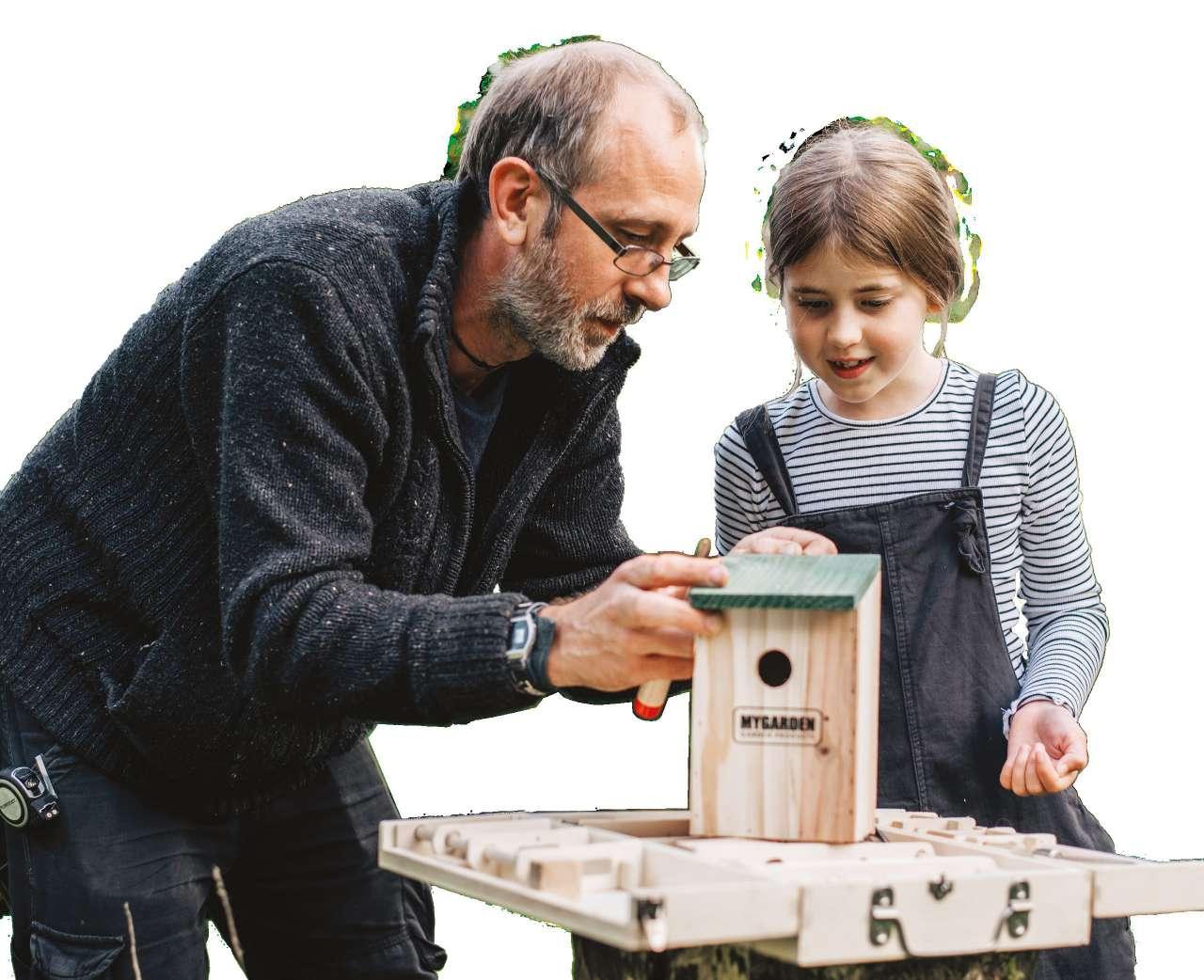
Let’s go 30 Days Wild Scan with your phone camera to sign up! wildlifetrusts.org/30DaysWild Sign up to take part in the UK’s biggest month-long nature challenge
Essex Wildlife Trust’s Ambassadors

Alfie Bowen
Alfie is a wildlife photographer and author. Growing up, Alfie sought solace in wildlife magazines and documentaries. Now, his work has been featured by BBC Earth. Securing the futures of the animals that star in his photographs inspires his work with Essex Wildlife Trust, WWF and Nikon. Alfie is also a passionate activist, fighting for the acceptance of those with Autism Spectrum Disorder. He is currently embarking on a tour of UK schools hoping to inspire the next generation.
14 WILD summer 2023 |
“ I am looking forward to joining the Trust at what is an important time for the future of the world's wildlife and am excited to be involved in conservation initiatives.”
ESSEX WILDLIFE TRUST'S AMBASSADORS
I am delighted to have been appointed as an Ambassador for Essex Wildlife Trust, the latest development in what has been, and is, a wild journey. I thought I would share a little more of that journey with you today.
Nature has always been a passion of mine, and almost all of my childhood was spent either playing with pretend animals or feeding the nearby ducks.
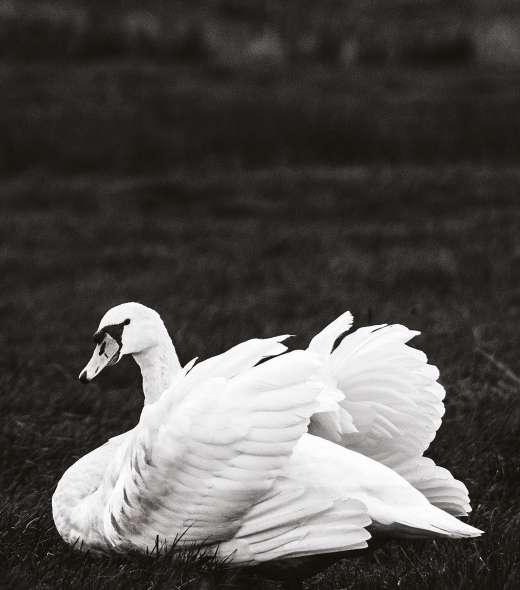
Many happy hours were spent outside in all weathers exploring the garden, playing in the mud and watching the many creatures that called it home. These experiences fuelled a great respect for the world we call home and I’ll always remember the holidays of my childhood in Weybourne Forest, Norfolk. These were family affairs, with my grandparents, aunty and uncle joining me, Mum and my sister Amie.
I spent much of my time in this magical woodland observing the numerous pigs, ducks, chickens and rabbits that were the owners’ much-loved pets. I used to sit on the veranda of our lodge for hours, peering into the abundance of swaying pine trees and glistening, needle-laden branches for a glimpse of the
elusive red squirrel. This often led to disappointment, but it never deterred me from doing the same the following morning. The buzz from the occasional sighting set my soul on fire.
Education was always a tough experience for me, with many people judging me because of my lack of social skills or inability to ‘fit in’, nobody ever bothered to say hello or smile at me. My obsession with wildlife quickly became my escape from the bad days, and my visits to the zoo or local nature reserves each weekend would be the highlight of my week — when I walked through the gates my anxiety disappeared, like the flick of a switch.
My obsession with nature and wildlife continued to grow, and this ultimately led to me picking up my mum’s compact Lumix camera, which was no bigger than my hand at the time, and I set about trying to photograph the animals that I loved spending my time with. I kept visiting the zoo every weekend, or more often if I could, and kept practising with my camera — it was the perfect distraction from the challenges I faced living with autism, and being surrounded by nature was incredibly healing.
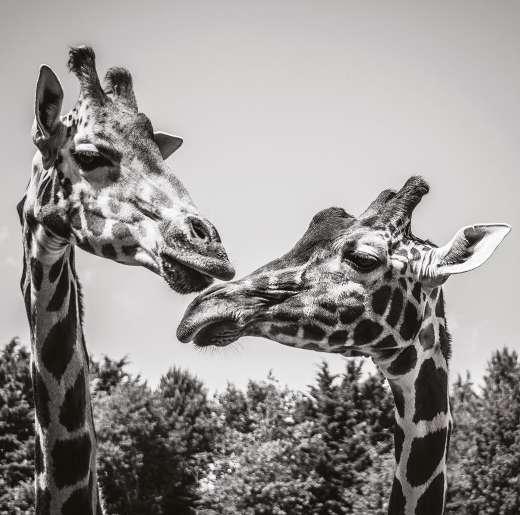
All these years later, having recently turned 25, I am still as obsessed with the natural world and its wildlife as I was at four years old, and I now know that I have autism to thank for that, because autism brings with it obsessions. I am extremely lucky to do what I do, I want to use the platform I have to change the world for others living with autism. I want to leave you with this thought — be kind to one another, say hello, smile and follow your passions.

15 WILD summer 2023 | ESSEX WILDLIFE TRUST'S AMBASSADORS
“ My artistic vision is shaped by a meticulous attention to detail and an unwavering determination to prove people wrong ”
Photos: Alfie Bowen
Re connecting

16 WILD summer 2023 Reconnecting rivers |
rivers
Gentle streams, trickling springs and running rivers are idyllic features of British landscapes. Aside from their beauty, rivers play a functional role as they travel from source to sea. In the UK, around 3,000 species rely on rivers, 200 of which are listed as rare, endangered or vulnerable. Find out how Essex Wildlife Trust is working to protect these vital freshwater habitats and the wildlife that relies on them.

17 WILD summer 2023 Reconnecting rivers |
Otter: Boma - stock.adobe.com
A freshwater network
Over centuries, the importance of rivers has become paramount. For people, rivers provide drinking water, irrigation for farming, aid with the transportation of goods, link together communities and are people’s livelihoods. For wildlife, they are an essential support system, providing a habitat to live, breed, feed, swim and shelter within.
There are around 42 native species of freshwater fish in the UK, such as carp, brown trout, flounder and lampreys, to name a few. Some of these species are migratory, using rivers as breeding grounds before returning to the sea in adulthood.

Rivers at risk
Sadly, river biodiversity is under threat. Over many years, Essex’s freshwater network has been fragmented and industrialised. Rivers have become drains for waste and chemicals, and man-made barriers such as weirs, locks, dams, and mills have substantially reduced the flow of rivers. Although built for a purpose at one time, many of these artificial barriers are no longer in use, leaving 97% of our river network interrupted. Fish navigating through a once-flowing river network are now unable to continue along migratory paths. This has a huge impact on wildlife, affecting the diversity and population of migratory fish
Eels are especially known for living parts of their extensive life cycle in our rivers.

Kingfishers, with their unmistakable bright blue and orange colourations, rely on rivers for finding their food source. Herons too, with big, wide wings, will stand statue-still in the riverbank reeds, waiting for an unsuspecting fish to appear. But birds are not the only wildlife that rely on rivers for food. Otters are semi-aquatic mammals, dipping below the waterline in search of their dinner. In the thick vegetation that borders our rivers, water voles leave nibble-sized marks in grasses before burrowing in steep banks to nest.
that are no longer able to access suitable spawning sites. Recovery for these species can be dangerously slow if fish cannot move back upstream, which also affects their predators like the hungry kingfisher, heron, and otter.

Reconnecting rivers
18 WILD Summer 2023 |
Grey heronBertie Gregory/2020VISION
Brown trout: Kletr - stock.adobe.com
European eel: PIXATERRA - stock.adobe.com-
The Essex Fish Migration Roadmap – a solution

Since 2018, Essex Wildlife Trust has been working in collaboration with the Thames Estuary Partnership and the Environment Agency to create The Essex Fish Migration Roadmap. By working together, a map of Essex rivers has been created, with 400 obstructions to fish passage also identified. Work has now commenced to remove or adapt each barrier, in an ambitious, decade-long project. Preferably, fish passages will be entirely removed, and rivers can resume their flow. However, this can be complicated and expensive, considering factors such as maintaining water levels and the risk of flooding. If a barrier cannot be removed, a bypass may be a secondary solution. So far, three barriers have been altered or removed. The roadmap is available to view on our website at www.essexwt.org.uk/essex-fish-migration-roadmap Find out what barriers are near you, and watch our roadmap turn from red to green.
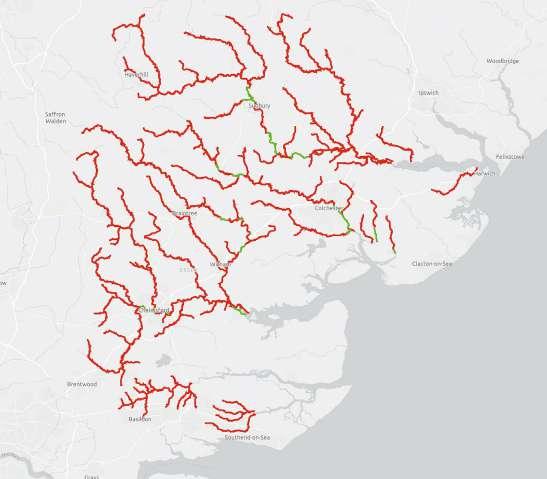
Dedham Mill on the River Stour
For centuries, Dedham Mill has been a barrier to fish migration. A weir prevented fish from passing through and the mill stopped fish returning downstream. In October 2022, an eel and fish pass was installed, as this barrier could not be removed. By lowering the centre of the weir and installing oak bars with gaps, a series of water-filled steps was created for fish to swim through. With additional toothlike black tiles, eels can wriggle through and continue their migratory journey.


19 WILD summer 2023 | Reconnecting rivers
Straits Mill Weir
Coggeshall Radial Gate
Completed fish pass
River Champions
The Trust has a huge team of volunteers helping to protect and monitor rivers. Over the past decade, 140 volunteers have won national awards for biological recording, made a rare discovery of brook lamprey in our rivers, and made a real difference in understanding Essex’s waterways. Due to the success of the scheme, River Wardens have undergone an evolution to become River Champions.
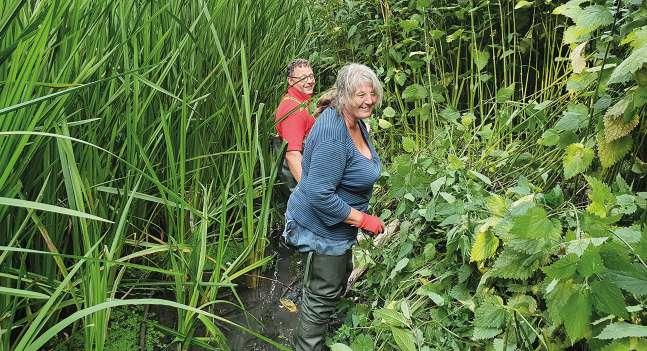
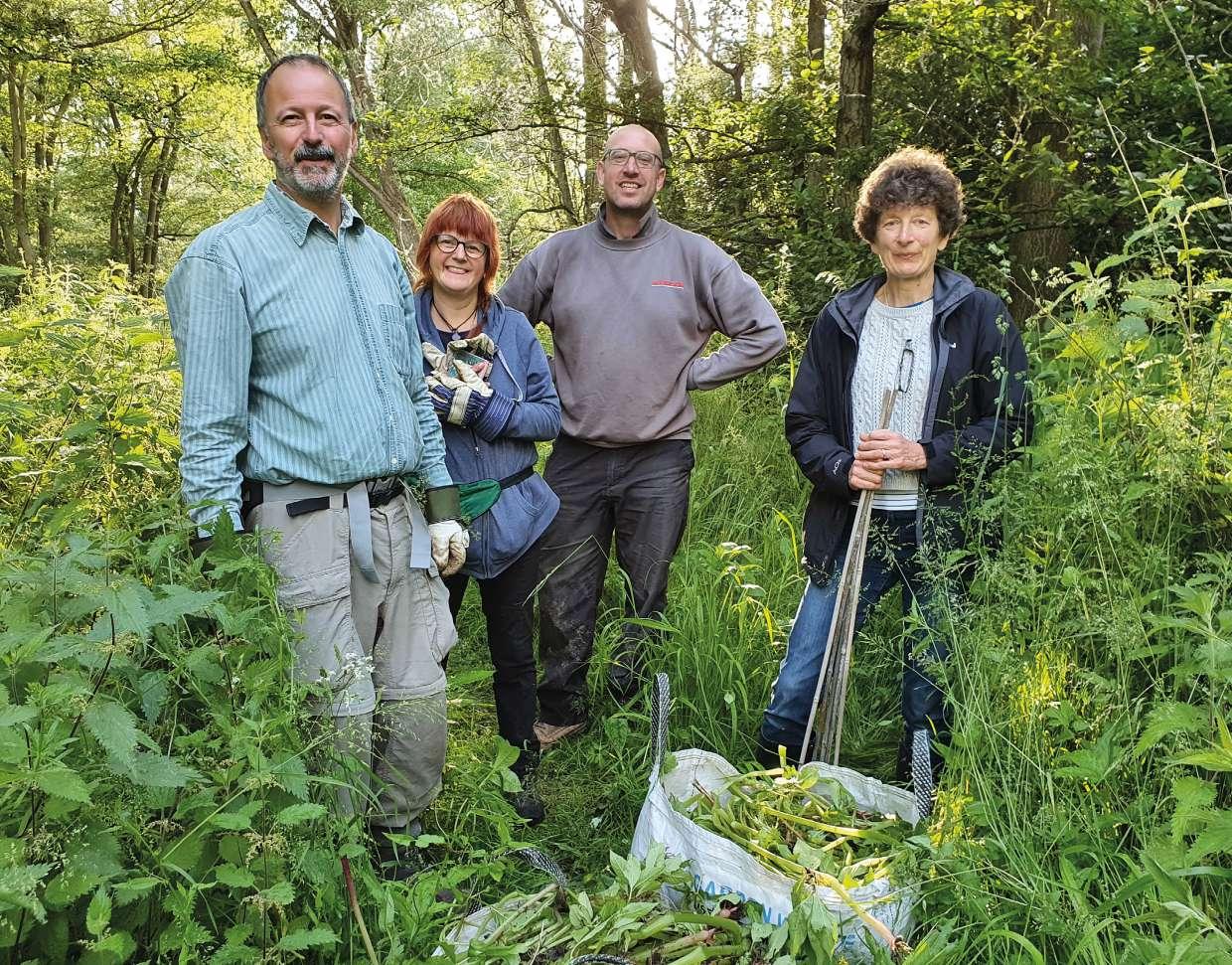
Over the last few years, Team Wilder has launched new projects such as Urban Wildlife Champions and Nextdoor Nature, helping communities to self-organise and make changes in their local environment with the support of the Trust. As such, River Champions is an evolution of the River Wardens scheme, that will enable many more people to take action for their river and help achieve our goal of 1 in 4 people acting for wildlife
River Champions, as part of that Team Wilder approach, introduces a much stronger community-led focus – encouraging groups to self-organise events such as litter picks, pollution watches, tree planting, and invasive species removal. For any action or event our River Champions want to deliver, our Wilder Communities team is on hand and eager to offer bespoke guidance and support.
River Champions will also be able to get involved in citizen science projects – many of which our previous River Wardens will have done before. This might be riverfly monitoring, or Environmental DNA (eDNA) water sampling – or perhaps surveying a local stretch of river for signs of our charming, but struggling, native water vole.
As a River Champion, you can get involved however best suits you. There will be opportunities to learn new technical skills, to learn surveying techniques – but those activities aren’t essential for you to be a River Champion.
If you would like more information about River Champions, visit: www.essexwt.org.uk/ river-champions or email Ben Mott, River Officer, on benm@essexwt.org.uk
20 WILD SUMMER 2023 |
Reconnecting rivers
River Champions photos: Tim Clarke
River Champions in action
Himalayan balsam is an invasive species which crowds out native plants and spreads rapidly. It dies back in winter leaving the exposed riverbank more susceptible to erosion. Balsam produces seed pods which explode, casting their seeds into the river and surrounding area.
Tim Clarke, River Champion, has been removing small outbreaks of Himalayan balsam for several years, determined not to let it spread locally.


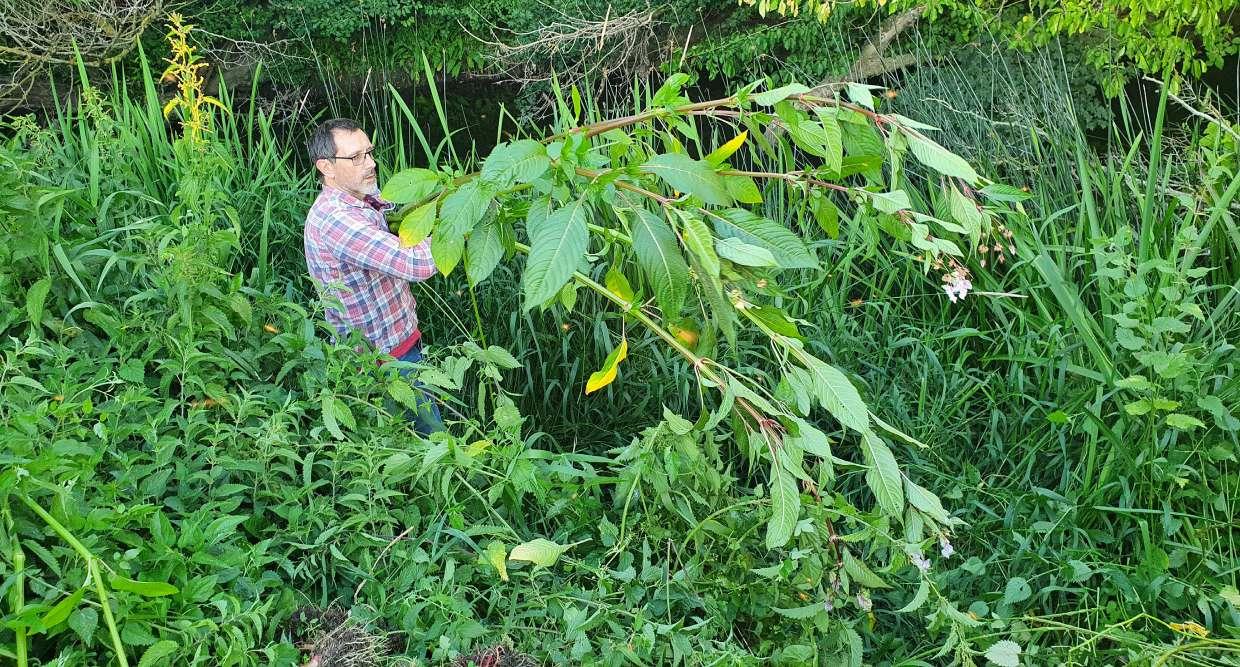
This is hot, uncomfortable and sometimes precarious work. The plants often grow on steep riverbanks and usually among nettles, so your forearms spend the summer tingling from stings. The early months of the season can be spent on hands and knees in nettle patches looking for and pulling up the young plants. In July and August, we were wading through six-foot-high stingers to pull up 10-foot-high plants.
Nonetheless, everyone in the team felt a real sense of achievement. Last summer, we cleared over 32,000 plants. The core team was Lindsey Cornes, Nicky Paine, Tom Hodgson, Kate Clifton, Tracey Kinns, Francis Ryall, Matt Vinogradoff and myself. We’ll be at it again this year.”
Tim wants to encourage the public to report sightings of balsam to the Trust so that River Champions can deal with it before it spreads.
“I know that the Trust has limited resources to remove balsam, and that it doesn’t just occur on their reserves, so last year I decided to organise a group to clear it. Last summer, we focused mainly on Roman River nature reserve in Colchester as two of our members manage the site. Roman River has been smothered in balsam for many years and the Trust has led numerous work parties to try and clear it.
Tim Clarke - balsam
Himalayan balsam: Tomas Vynikal - stock.adobe.com
Reconnecting rivers 21 WILD summer 2023
Top 10 river species in Essex


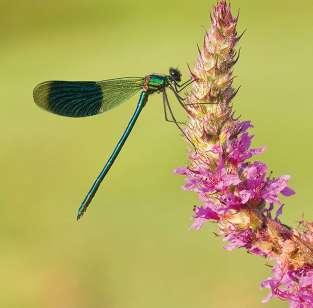
Otter

Returned from extinction in the 1980s, they are adapted to life on land and in the water.
Now part of a regional recovery project, these native mammals nest in riverbanks.

The iconic river bird. Appears azure blue even though its feathers are actually grey.
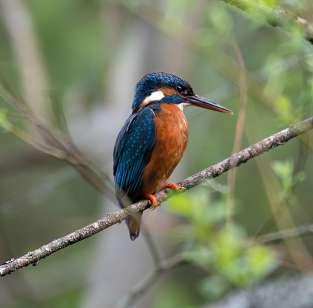
A classic bird of mills and weirs and much more yellow than its name suggests.
As seen on Wild Isles, males have a distinctive blue thumbprint on their wings and their abdomens are stunning iridescent blue.
The larvae protect themselves by constructing different cases from materials as varied as sand, stones, vegetation and even shells.

A great indicator of clean water and one that lives on the riverbed. Known as ‘Miller’s Thumb’.
A predatory fish that has ‘tiger’ stripes along its sides. Spiny fins help deter predators, but otters still feed on them.

Spikes of purple flowers colour river banks and attract pollinators.
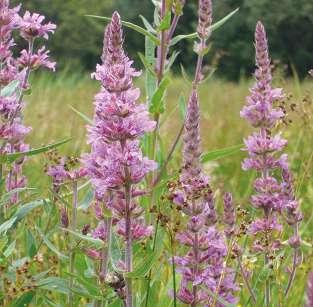
Possibly our most common ‘emergent’ species growing in the river channel with distinctive globular seed heads in the summer.
Otter - Andy Rouse/2020VISION, water vole - Terry Whittaker/2020VISION, kingfisher - Jon Hawkins – Surrey Hills Photography, grey wagtail - Terry Whittaker/2020VISION, banded demoiselle - Mark Hamblin2020VISION, cased caddisfly - troutnut - stock.adobe.com, bullhead - Jack Perks, perch - Jack Perks, purple loosestrife - Lizzie Wilberforce, branched bur-reed - EMFA16 - stock.adobe.com.

Reconnecting rivers
1.
5. Banded demoiselle
2. Water vole
6. Cased caddisfly
3. Kingfisher
7. Bullhead
9. Purple loosestrife
4. Grey wagtail
8. Perch
10. Branched bur-reed
1 3 5 7 9 2 4 6 8 10
22 WILD SUMMER 2023 |

A study of Wildlife Trust volunteers
of
low mental wellbeing
of
Registered Charity No. 210065 Love Essex • Love Wildlife Discover upcoming opportunities at www.essexwt.org.uk/get-involved/volunteer
showed that 95%
participants with
at the start
volunteering reported an improvement in six weeks.
Hanningfield Reservoir
Nature Discovery Park

Opened in 2000 as a Millennium Project, Hanningfield Reservoir
Nature Discovery Centre provides panoramic views across the 352-hectare reservoir and acts as a gateway to the wooded nature reserve. With three trails, four bird hides, an abundance of wildlife in the woodland and on the reservoir and events throughout the year, there is something for everyone to enjoy at Hanningfield. w
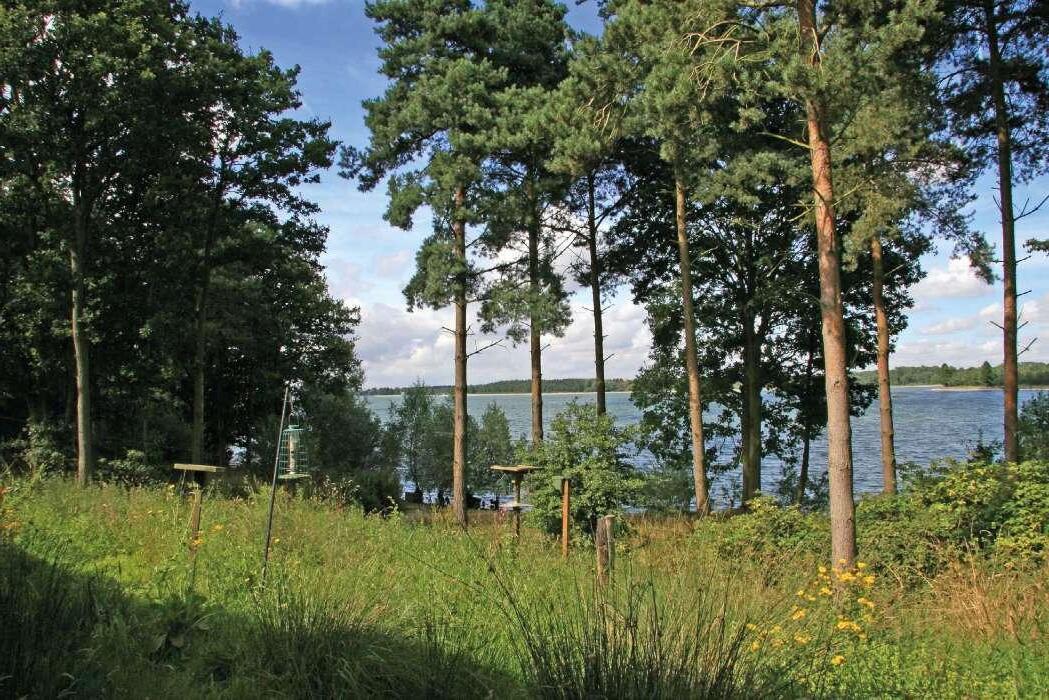
Hanningfield reservoir nature discovery Park summer 2023
What to look out for this summer at Hanningfield Reservoir
Soprano pipistrelle bats
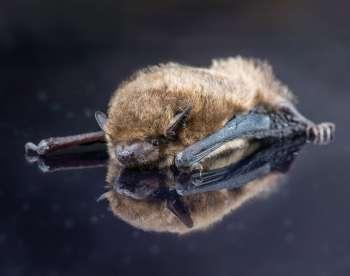
A maternity roost of hundreds of these tiny bats lives within the roof and bat box just outside of the centre. Summer sees them raise their young, leaving their roost site at dusk to feed on insects.
White-letter hairstreak

This delicate butterfly can be seen flitting around the tops of trees, coming down to feed on the flowers of privet and bramble.
Coots

Over 2,000 of these smart looking water birds can be seen gathering together on the reservoir in late summer.
Wood ants
The southern wood ant is our largest ant species in the UK, with workers reaching 10mm in length and queens 12mm. Look for their giant nests, built in open woodland glades that are well exposed to sunlight.

Common tern

Watch these elegant silvery-grey birds dive down dramatically to catch fish, or noisily chat amongst colony on the tern raft.
Billie’s facts
Hanningfield Reservoir Nature Discovery Park Size: 40 hectares.
Address: Hawkswood Road, Downham, Billericay, CM11 1WT.
Access: Open daily from 10am – 5pm, check the website for up-to-date times before visiting. Free, large car park available. There are various routes around the reserve, accessible through the Nature Discovery Centre, including The Wind in the Willows themed trail. Several trails are wheelchair friendly, please call the centre for details.
Hanningfield reservoir nature discovery Park
White-letter hairstreak photo: Sandra Standbridge - stock.adobe.com, soprano pipistrelle bat photo: bearacreative - stock.adobe.com, coot photo: Andrew Parkinson/2020VISION, wood ant photo: Ross Hoddinott/2020VISION, common tern photo: Donald Sutherland. WILD summer 2023
After the Second World War, demand for water increased significantly in Essex, with the development of towns such as Basildon New Town and Harold Hill. In January 1949, South Essex Waterworks and the Southend Waterworks Company announced their big project to combat this – Hanningfield Reservoir.
In 1950, the Hanningfield Water Order was passed, allowing the construction of a reservoir, treatment works and the laying of a water main from Langford that would fill the reservoir from the Chelmer and Blackwater rivers, while also reducing their risk of flooding.
The Sandon Valley with its saucer shape and natural river valley was identified as the perfect location. The area to be flooded consisted of a few farms but covered the ancient tiny hamlet of Peasdown. People were relocated from their homes and the notable buildings of Giffords Farm and the gabled mansion Fremnells Manor House needed to be demolished, which caused initial uproar.
The Elizabethan Fremnells Manor House was the seat of the Tyrell family from 1476-1627, when it came into the possession of Benjamin Disbrowe, son of Major General John Disbrowe who was married to Jane Cromwell, a sister of Oliver Cromwell.
All of the existing buildings were cleared, meaning no ghost settlements would re-emerge in drought years. Over 1,000,000 cubic yards of gravel were used to complete the scheme, transporting this from 4-10 miles away. Then, almost 1,000 acres of land was flooded, forming a reservoir between the villages of West and South Hanningfield.

Construction was completed in 1956, costing around £6 million. The reservoir was then left to fill over the course of 200 days and the site was put into supply the same year, officially opening in September 1957. The reservoir serves people in Southend, Thurrock and the London Boroughs of Barking, Dagenham and Redbridge, providing 150 million litres to half a million homes every day. With a surface area of 352 hectares, the Essex & Suffolk Water owned reservoir contains enough water for 200 days of supply and is the 11th largest reservoir in England. At its deepest point it reaches 16.76 metres, or 55 feet.
Land surrounding the reservoir was left for nature, with over 100 hectares of woodland. What initially was a shock to the farming community, the reservoir is now a muchappreciated oasis of flora and fauna. Hanningfield Reservoir was recognised for its importance for wildlife in 1966 when

it was designated as a Site of Special Scientific Interest (SSSI) for wildfowl. The reservoir has a nationally important population of gadwall and significant numbers of pochard, teal, tufted duck and pintail. Through the summer months, watch thousands of swifts, swallows, martins and several species of bat fly over the water to feed on the fly hatches. The reservoir used to have a water quality monitoring station called the ‘iron lady’, but this has now been turned into a raft for terns to nest and rest on. The chalk sludge lagoon also provides a home for several unusual plants, including golden dock, marsh dock and the rare moss Brachythecium mildeanum at the foot of the southern dam.
Essex & Suffolk Water and Essex Wildlife Trust have been working in partnership since 1992, when the Trust took on the management of the new Hanningfield nature reserve for the benefit of wildlife. The nature reserve consists of 40 hectares with a mosaic of habitats including ancient woodlands, open glades, farmland, nature trails and four bird hides, with Lyster Hide being fully accessible so everyone can enjoy the reservoir.
There are three circular trails around the reserve. Well Wood takes you to RAWL Hide (named after the volunteers who built it), across the pond boardwalk where dragonflies zoom by, past historic oak trees and through an ancient hornbeam coppice. In spring, bluebells carpet the woodland floor, while woodpeckers nest in the tree trunks. Hawks Wood is lined by towering foxgloves and delicate wood melick. Look for colonies of wood ants scuttling across their impressive nests, and large bracket fungi growing on birch. For family fun, you can follow the much-loved The Wind in the Willows Trail, with sculptures of Mole, Toad, Badger and friends.
Before the 1950s, most of the trees in the woodland were hornbeams. This native tree was used to make good quality firewood and charcoal. Traditionally, the trees would have been cut down to near ground level, allowing people to use
26 | Hanningfield reservoir nature discovery Park WILD summer 2023
Fremnells Manor House
the resources, and then allowing them to regrow – a practice known as coppicing. Once the demand for coppiced wood products dwindled, the woodland was replaced by a fastgrowing North American timber crop.

Essex Wildlife Trust is working to replace the non-native conifers with the original native tree species that were found here, to improve the biodiversity of the site. Coppicing is an important part of this process, creating space and light in the woodland canopy, vital for wildflowers like bluebells, wood anemone and dog violets. Where new wildflowers grow, insects follow. The buzz of bees and flutter of butterflies are never far behind their colourful blooms and sweet scents. Low-cover nesting birds also utilise the shelter that coppiced woodland provides. The Trust’s warden is supported by 12-15 work party volunteers that help manage the nature reserve two days a week, for wildlife and to help provide access and easy connection to nature for Hanningfield’s many visitors.
It became easier for the public to visit the reservoir when Essex Wildlife Trust opened its visitor centre in 2000, as a Millennium Project. The centre had a grand opening in November 2000 and now welcomes over 60,000 people each year to its accessible centre with panoramic views of the reservoir.
A soprano pipistrelle maternity roost quickly took up residence in the roof of the centre, so a specific bat box was designed, built and donated by Maurice Webber of Conservation Constructions Ltd in 2009 to support the thriving bat population. In July 2019, a total of 1,786 bats were counted – the largest ever reported for a soprano pipistrelle bat roost as recorded by the Bat Conservation Trust’s National Bat Monitoring Programme. You can now watch these bats up close on Essex Wildlife Trust’s live bat webcam at www.essexwt.org.uk/bat-webcam
Events and activities at Hanningfield Nature Discovery Centre


We run a variety of walks, workshops, and events throughout the year, with a packed schedule for the summer months. Our two Wilder Learning Officers, Jane-Marie Osbourne and Beck Fitzpatrick provide educational activities, outdoor learning and outreach all year round. Their pre-school Nature Tots group is ever popular, running two days a week in the school holidays. Forest School drop-off days are always popular, a chance for children to properly connect with nature at Hanningfield, while having fun! There are many opportunities for children of all ages to explore, discover and get creative in nature.
This summer, we are also hosting photography workshops by Daniel Bridge, including a session on ‘Composition and Light’ on Sunday 11 June and getting up-close to nature with ‘Close-up and Macro Photography’ on Saturday 15 July.
Details of all of our upcoming events will be available on Essex Wildlife Trust’s website at www.essexwt.org.uk/ events, Essex Wildlife Trust Hanningfield Wick Nature Discovery Park Facebook page or at the centre itself. Pop in to talk to one of our staff members, or call the centre directly on 01268 711001
27 WILD summer 2023 | Hanningfield reservoir nature discovery Park
Soil Sampling
Photo: Adrian Clarke
Wilder learning
The bright mornings and longer, lighter evenings mean we can get out and about to explore nature. Wildlife is bursting around us with flowers in full bloom, birds singing and bees buzzing. Take the opportunity this summer to enjoy the cool sea breeze on a hot day or take shade in some of our ancient woodlands. We’ve got a jam-packed calendar of activities to help you learn more about nature, with something for everyone.
Our calendar has already been full this spring with lots to see and learn. We’ve been exploring thriving pond life at Chigwell, seen ladybirds out in their hordes at Ingrebourne and fed the red deer at Bedfords. There’s been activities to hunt dinosaur eggs at Belfairs and search for coastal life at the Naze.
We have so many more activities to get you outside interacting with nature. Make sure to join us for National Marine Week running from 22 July - 6 August 2023. We will be hosting seashore exploring sessions, beach play and working with Impamark to run outreach sessions about recycling and plastic waste across our Essex coastline. We also have a family seashore explorer event at The Naze on Thursday 27 July, come along and learn more about the marine life on your doorstep.
Belfair’s Nature Discovery Centre is turning 10 this year, come and join the celebrations at the end of summer with special wild activities. We will also be attending the Tendring show with activities for all the family 8 - 9 July. Make sure you come and find us there!
There are lots of opportunities to try out our popular under 5’s Nature Tots sessions at Abberton, Belfairs, Langdon and Ingrebourne. These weekly parent and toddler groups allow young children to explore, play and learn through nature, suitable for ages 18 months to 5 years.

The fun doesn’t stop there though, perhaps you’ll join us soon for our Forest School Drop-Off Day adventures. Children can learn bushcraft skills, make shelters, climb trees and use natural materials for crafts. Suitable for children aged 5 - 12. See who you can discover living in our woodlands and meadows at one of our Nature Discovery Centres!
Keep up to date with all our Wilder Learning sessions at www.essexwt.org.uk/events
During the summer holidays, we run lots of activities to get your children outside. From creative crafts to pond dipping, woodland fun to bird box making, there is something for all the family to enjoy.

Wilder Learning 28 WILD Summer 2023 |






































































































































SOFAS & CHAIRS CARPETS & RUGS BEDS & MATTRESSES MALDIVES Corner Garden Set. Peartree Road, Stanway, Colchester, Essex CO3 0LA 01206 765444 www.hatfields.com Let’s Get Social #HatfieldsAtHome
Your step-by-step guide to making a bee bath
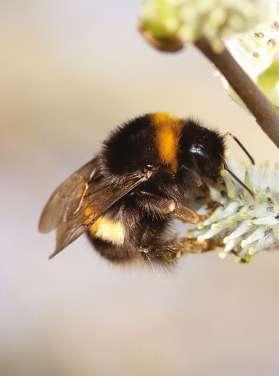
Sat outside with a cuppa, enjoying the sunshine? You’re not the only one who may be thirsty in the warmer weather. During the summer months, our gardens are full of the familiar humming of busy bees going about their business. Water plays a vital role in a bee’s life, they use water to process their food, to drink, and to collect and take back to the hive. Why not install a bee bath to help these thirsty workers and attract more bees to your garden?
What you will need
• A small shallow plate or bowl
• Stones in varying sizes
• Fresh water
Step 1
Add the stones to your plate. Choose a water-safe dish such as glass or ceramic, as plastics may seep into the water.
Step 2
Fill the plate or bowl with water, leaving the top of the stones clear. Do not submerge the stones completely, as this provides a safe place for bees to stand whilst drinking.



Benefits of a bee bath:
• Providing a much-welcomed drink helps our busy pollinators to rest and replenish whilst foraging, preventing exhaustion, something they’ll be very grateful for during the hotter days.
• We all need water to keep our bodies healthy, and so do bees! This helps to aid with digestion.
• Honeybees use water to cool down the temperature of their hive, by placing drops of water inside and letting these evaporate. They also use water to dilute honey and prevent it from crystallising.
If you make your own bee bath, we’d love to see it. Send your pictures to magazine@essexwt.org.uk
Step 3
Place your bee bath in a shady, protected area. If you can position your bee bath next to some of their favourite flowers then this is a bonus! Alternatively, you can put your bee bath on an upturned plant pot.
Tips:
• Replace the water daily and clean the bee bath once a week.
• If possible, position your bee bath away from bird baths and ponds. The bee will quickly learn where there is a safer water source.
Our pick of summer plants for bees •
BumblebeeTom Marshall
Lavender • foxgloves • buddleia • alliums
honeysuckle • Dahlia • Heather • Aster How to help wildlife 30 WILD Summer 2023 |
•
Recycled & Repurposed
Recycling and repurposing waste that would go to landfill to make durable and long-lasting products is a huge step forward in making the world a greener place. That’s why ROKA make their bags using recycled material.
ROKA bags are now available to buy in our Nature Discovery Centres .

Registered Charity No. 210065
•
Love Essex
Love Wildlife

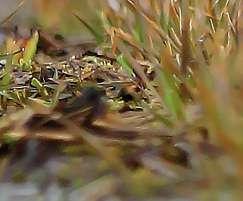
Restoring wonderful wetlands 32 WILD Summer 2023 |
Wonderful wetlands Restoring

Wetlands are formed when water saturates the land permanently or for a period of time. Whether it is the turning of the tide or seasonal rainfall, these dynamic ecosystems are constantly changing and support over 40% of the world’s wildlife. Wetlands take many forms such as grassland soaked with rain, muddy bogs, swamps and intertidal areas. They also have a positive impact on humans. Protecting us from storm surges, acting as coastal buffers in high tides and helping us fight climate change by storing carbon are all advantages of wetlands.

33 WILD Summer 2023 | Restoring wonderful wetlands
Lapwing
photo: Yakubovich Dmitry - stock.adobe.com
In Essex, rainfall is less frequent, making it one of the driest counties in the UK. Additionally, the UK has lost 90% of wetland habitats in just one hundred years, caused by draining them to make way for agriculture, urban developments, forestry and other land uses. For species that rely on wet, marshy, muddy places to live, breed and feed, these habitats can be harder to find in the warmer months.
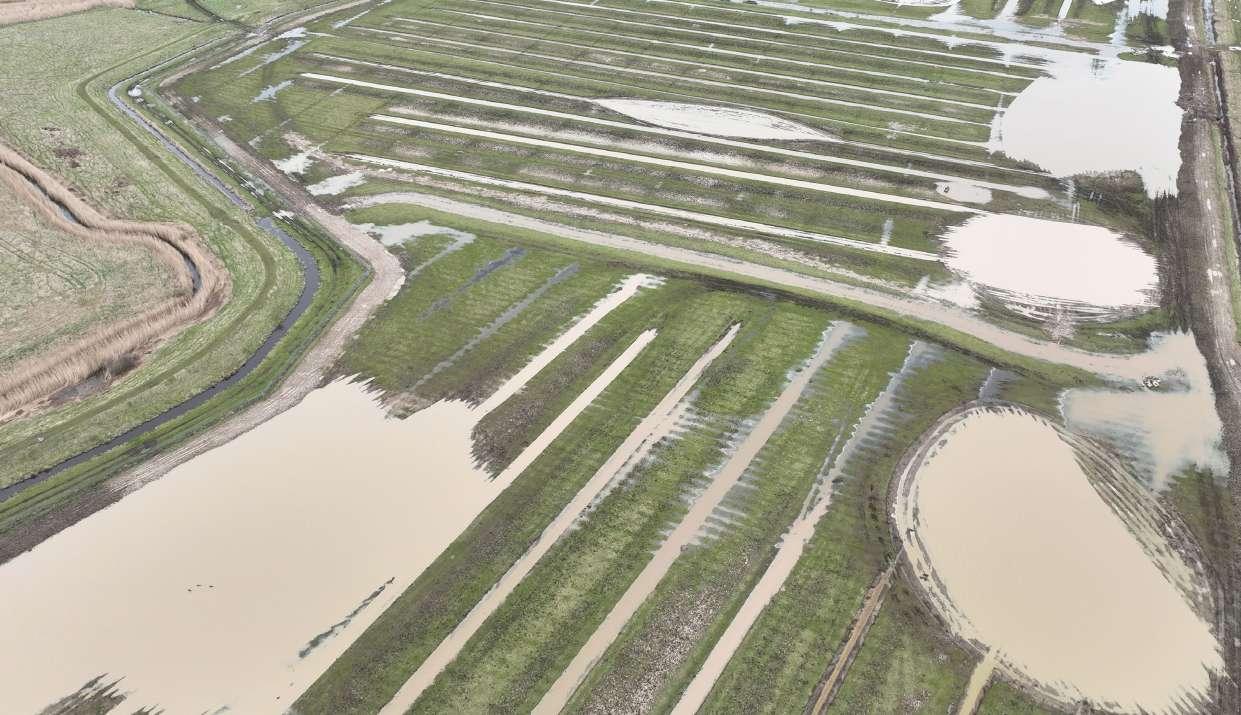
Essex Wildlife Trust is working to restore and protect these habitats in Essex.
Blue House Farm nature reserve
Blue House Farm is internationally renowned as a hotspot for birds, attracting thousands of dark-bellied brent geese each year. The nearby Crouch Estuary and abundant grassland habitat provide roosting and feeding grounds for migratory winter waders and year-round visitors.
In the spring of 2022, an ambitious project began at Blue House Farm nature reserve to create over 40 hectares of new wetland. Shallow ditches and mounds, known as scrapes, have been shaped to hold rainfall throughout the year. On a hot summer’s day, pools of collected water are lifelines for semi-aquatic species like dragonflies, water voles and newts.

On the shallow muddy marsh banks, wading birds will paddle and forage for food using their long legs and beaks. In the wet grasslands, you’ll find vulnerable ground-nesting birds like lapwing and redshank.
Lapwing, often nicknamed ‘peewits’ after their call, have undergone marked declines in the past few decades alone. Since 1967, the population in the UK has more than halved. On the red list for conservation, these birds rely on safe places to create their nest on the ground, preferring bare ground or short grasses to conceal their eggs.

Restoring wonderful wetlands
Hairy dragonfly photo: Chris Lawrence
34 WILD Summer 2023 |
A breeding pair of lapwing have already started to settle into the new wetland area protected by fencing, as shown by this nest found by our Conservation Team.
In the spring of 2022, an ambitious project began at Blue House Farm nature reserve to create over 40 hectares of new wetland.
Blue House Farm wetland creation
“
Similarly, redshank are threatened by a loss of breeding and wintering habitats, which is why a new wetland area is so vital for this species in particular. These birds seek out short, damp grasslands for feeding and making their nest.
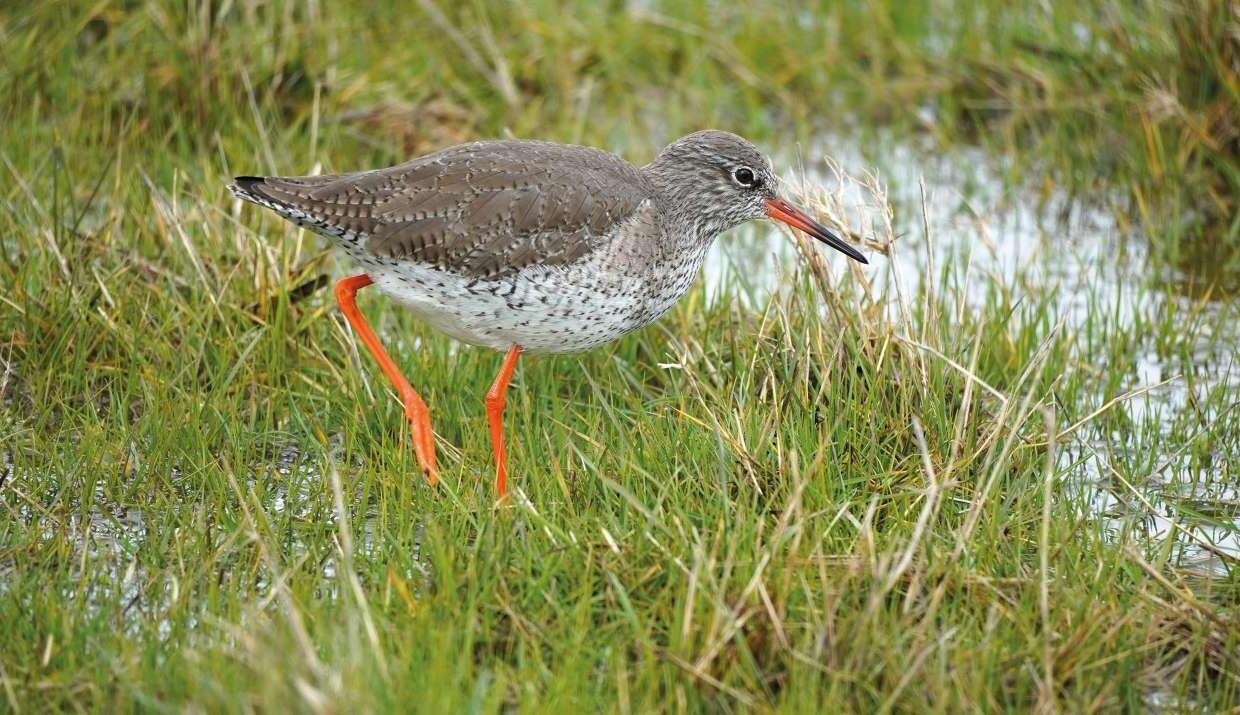
Around the newly-created area, a tall fence encloses the habitat, designed to keep young chicks safe from predation. The wetland has already gathered rainfall throughout early spring, and the Trust looks forward to surveying the success of ground-nesting bird breeding seasons in the future.
This project was funded by Biffa Award as part of the Landfill Communities Fund with support from Branch Out, Gifts in Wills from Mollie Drake MBE, Clive Fenner and Valerie Thomas, and thanks to the generous donations in memory of Jack Wratten, Ken Taylor and John Bugg.
Rachel Maidment, Grants Manager for Biffa Award, says:
Biffa Award is extremely delighted to support Essex Wildlife Trust’s project to transform a South Essex coastal habitat. The work that has taken place at Blue House Farm is vital for the natural environment, creating a productive area for breeding birds, as well as improving soil health and carbon storage that help deliver climate change resilience. Through our Partnership Grants Scheme we are able to make significant grants to projects that introduce, conserve or protect our wildlife, paving the way for nature’s recovery on a large scale.”
Say no to PEAT!
Fobbing Marsh nature reserve
This year, the initial phase of habitat restoration has been completed at Fobbing Marsh nature reserve, improving and restoring wetland habitat at this site. Previously, the site was not supporting breeding waders and wintering bird numbers were lower than comparable local sites. Throughout the year, the site was unable to store rainfall or control water levels, and the ditch systems were drying too frequently.
The winter rainfall needed to be retained for longer into the spring and early summer to maintain optimum conditions for ground-nesting wading birds, particularly lapwing, and to support characteristic plant and animal communities, including water voles and aquatic invertebrates. As one of the few remaining grazing marshes in South Essex, the habitat supports hundreds of species.

This project has been made possible thanks to the Water Environment Infrastructure Fund (WEIF), Anglian Water and Gifts in Wills from Daphne Cotgrove.
Peat is a vital wetland habitat for wildlife that takes thousands of years to form. Join the movement of gardeners pledging to go peat-free: www.wildlifetrusts.org/pledge-peat-free

Rivers
Restoring wonderful wetlands 35 WILD Summer 2023 |
Redshank photo: Jim Higham
Habitat restoration at Fobbing Marsh nature reserve
Old Park Meadow Natural Burial Ground








Between Chelmsford & Great Dunmow, Essex, CM6 3PL @OldParkMeadow @oldparkmeadow 01245 806332 Coppice Lane, North End,
offer burials and ash interments, funerals, services and wakes.
to any ceremony and a completely personalised service Reserving a plot in advance is also possible. A caring and compassionate experience through a difficult time
We
Adaptable
01206 764477 www.ellisonssolicitors.com WE HAVE BEEN PROVIDING EXPERT ADVICE FOR MORE THAN 250 YEARS
info@oldparkmeadow.co.uk
Ellisons Legal LLP is authorised and regulated by the Solicitors Regulation Authority (SRA Number 8001031)
Colchester | Ipswich | Chelmsford | Bury St Edmunds | Tendring
IN MEMORY DONATIONS

June’s story
Every so often we receive large and rather wonderful surprise donations. One such recent donation was from June Gage who had received a gift from her late father’s estate and wanted to pass some on to us purely because “he would’ve liked that”. I had the pleasure of speaking to June to thank her for this generous donation, but I always like to know what sparks the generosity of the public.
June told me all about her father, Tom Edgson, and his love of birds. Tom kept an aviary for as long as she can remember, but in later years he kept chickens on his allotment. What he really loved was feeding the wild birds and the visiting wildlife. He was careful on his allotment to not cut certain hedges in case birds



were using them for shelter and always encouraged wildlife visitors.
What always strikes me when speaking to the public is that our love of wildlife is often passed down through our parents and family members. June delighted in telling me that she has no less than four hedgehog houses in her garden. It is clear that Tom has had a big influence on her connection with nature.
“We are truly grateful for all the ‘In Memory’ donations we receive whatever their size as they help us fund vital work to help the wildlife of Essex. There are many ways in which to give, but the easiest way is via our dedicated ‘In Memory’ webpage where you can leave a dedication and photograph alongside your donation.”
Scan the QR code to find out how to make an in memory donation or visit www.essexwt.org.uk/in-memory
Lizzy Steward, Legacy Officer
Photos of Tom Edgson
37 WILD Summer 2023 | In memory donations
Blackbird photo: Amy Lewis
Wildlife
after dark
As we go to sleep, wildlife around us is waking up.
Throughout the warmer months, woodlands, beaches and meadows provide the perfect backdrop for butterflies, birds, and bees to dazzle in the summer sunshine. Golden light bounces off iridescent wings and ponds reflect bright blue skies. After a long day soaking in summer’s spectacles, you can tumble into bed exhausted and recharge for tomorrow’s adventure. As you drift off, all is not quiet. Have you ever wondered what wildlife is only just waking up? Under the cover of darkness, habitats come alive with a whole new set of species.
Why are animals nocturnal?
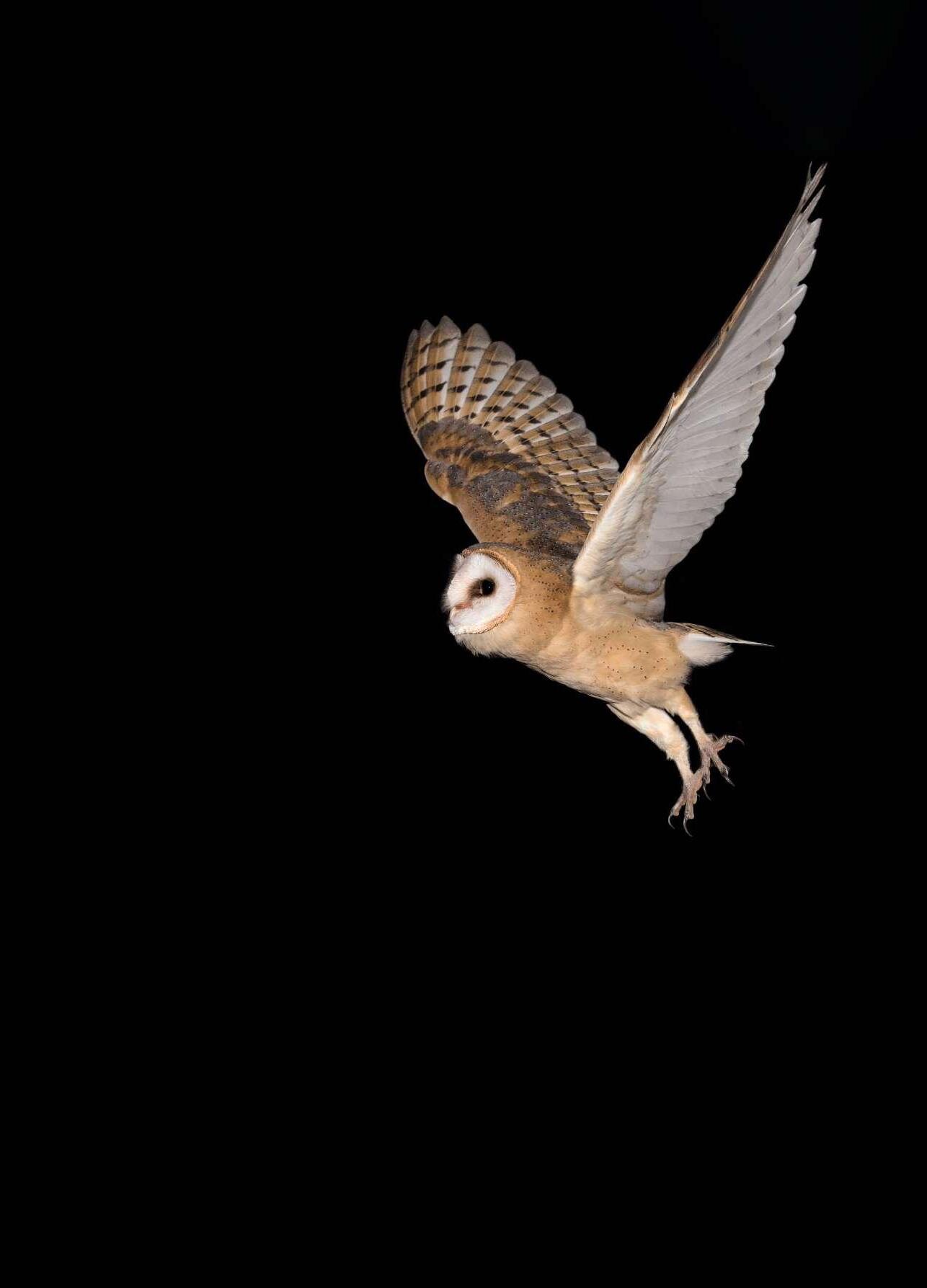
Around 70% of wildlife is active at night, meaning they are nocturnal. Most believe that animals adapted to nocturnal life to avoid daytime predators. Other factors include mating, food availability and safety when looking for shelter. In some cases, climate can dictate sleeping patterns.
that is active during the day.
humans!
Wildlife Active after sunset. e.g. pipistrelle bat
38 WILD Summer 2023 | Wildlife after dark
Diurnal Nocturnal Crepuscular Vespertine Crepuscular Matutinal Sunrise Sunset
e.g.
Active at dusk and dawn. e.g. barn owl Active early in the morning, before sunrise. e.g. honeybee
Species are not easily placed in these categories. For example, many birds are diurnal but may also be busy at dawn – hence the symphony of the dawn chorus that wildlife lovers anticipate in the late spring and summer. Spiders, for example, can be nocturnal, diurnal or crepuscular! that is active at night. e.g. hedgehog
Wildlife
Birds Owl
After a peaceful 10-hour nap, high up in the branches or nestled in their roost, owls take the setting of the sun as their alarm clock.
Nightjar
Found on heathlands, moorlands and open woodlands in the summer, the nightjar will sit quietly in trees until the night appears and it swoops to capture moths, flies and beetles.

Mammals
Bat
Finding food in the pitch black of night is no easy feat. By sending out high-frequency sound pulses through their mouth or nose, and listening to the echo it produces, bats can sense where things are. This is known as echolocation.
Badger
Emerging from their setts at dusk, the night-time is important for badgers to feed, mate and socialise. Badgers and cubs play by chasing others and tumbling around, while others form bonds by grooming each other.
Hedgehog
With less competition around at night for their favourite food sources, hedgehogs will roam up to 3km hoovering up slugs, beetles and caterpillars. Despite their ‘sharp’ appearance, these little mammals are timid, shying away from the noises and busyness of the daytime.
Explore wildlife at night

• Watch badgers, bats and owls on our live webcams.

• From glow-worm watching to badger watching to stargazing, book on to one of Essex Wildlife Trust’s events after the sun sets to experience wildlife at night.
• Set up a camera trap in your garden and see what visitors you might have near you.
Insects
Snails
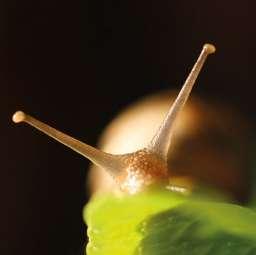
Most land snails are nocturnal, but sometimes a rainy day can entice them out of their hiding places earlier. They prefer cooler temperatures and higher humidity typically found after the sun sets.
Moths
Of the 800 species of larger moths in the UK, most are strictly nocturnal. It is said that moths have evolved to life in the dark to match their dark colouration. Moths will feed on sweet liquids from flower nectar, rotting fruits, sap, and even animal droppings.
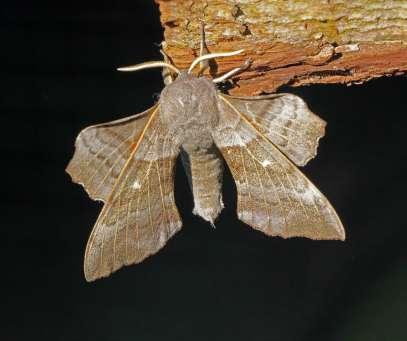
Marine life
Hermit crab
Spending the daytime in the sunshine is a no-go for hermit crabs. To save them from the harsh summer sun, and predators hunting during the day, they come alive at night instead.
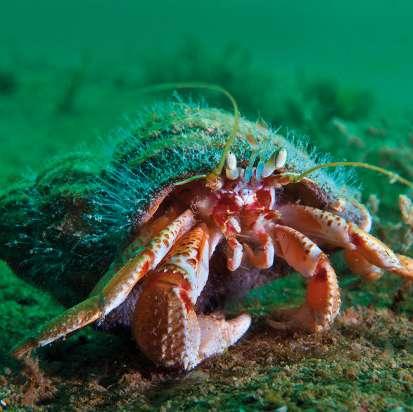
Common starfish
Although they may seem stagnant, these star-shaped creatures make their movements under the cover of darkness using the short spines on their arms.
Hermitcrab
Badger
Wildlife after dark 39 WILD Summer 2023 |
Poplar hawkmoth
Nightjar Garden s n ail
Poplar hawkmoth: Margaret Holland, hermit crab: Alexander Mustard/2020VISION, garden snail: Austin Morley, badger: Russell Savory, nightjar: David Tipling2020VISION, barn owl photo: manuel - stock.adobe.com
The secret life of ponds
Ponds of any size are cool pools to rest, feed and breed for wildlife. Birds and bats will swoop curiously overhead to investigate ponds, rich in aquatic insects. Use your detective skills and scan a pond’s muddy edge – can you spot any footprints? Badgers, muntjacs, hedgehogs or foxes may leave their tracks behind when venturing for a refreshing drink.
Kingfisher
Watch for a flash of azure blue and metallic copper as they dart along the bank, hunting for fish.
Emerald damselfly
This metallic-green damselfly lives along lush vegetation of ponds, lakes, ditches and canals.
Toad
Toads migrate annually from woodlands to their ancestral breeding pond, which could be over 1km away!
Marsh marigold

This large buttercup-shaped flower decorates marshy, wet places with its vibrant yellow petals.
Toad spawn
Common reed
These large and feathery flower spikes first appear dark purple, before slowly fading to brown.
Little grebe
These fluffy-tailed birds have a shy nature and are quick to dive under the water when disturbed.
Look for long clumps of jelly-like eggs in long ribbons. Inside, tiny black tadpoles wriggle and squirm.
40 WILD Summer 2023 | Pond illustration WOOD ANEMONES © MARK HAMBLIN/2020VISION
secret
of ponds
The
life
Ruddy darter
These red-bodied insects will perch quietly before darting forward suddenly to catch their prey.
Great crested newt
Underneath their black bodies, an abdomen of abstract colour is revealed – yellow and orange splodges decorate their bellies.
Willow tree
Long, flowing branches and leaves drape elegantly over the water’s edge.
Moorhen

A familiar black bird, with yellow legs and a red beak with a bright yellow tip.
Mallard
Great diving beetle
Named for their similarity to divers, they carry a personal air supply, tucked safely underwing for when they need a breath.
Shimmering green-headed males with bright yellow bills of males contrast with the dappled-brown feathers of females.
Smooth newt
Breeds in ponds during the spring and then spends the rest of the year feeding on invertebrates in woodland, hedgerows and tussocky grassland.
41 WILD Summer 2023 The secret life of ponds |
Nature Discovery Centres
Explore the wildlife wonders of Essex at one of our Nature Discovery Centres this summer. With delicious food and drink offers, wildlife hides, and the return of some of our favourite events, there’s something for everyone to enjoy.

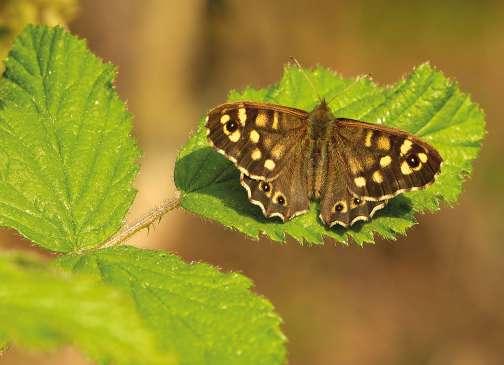
Bedfords Park Nature Discovery Centre
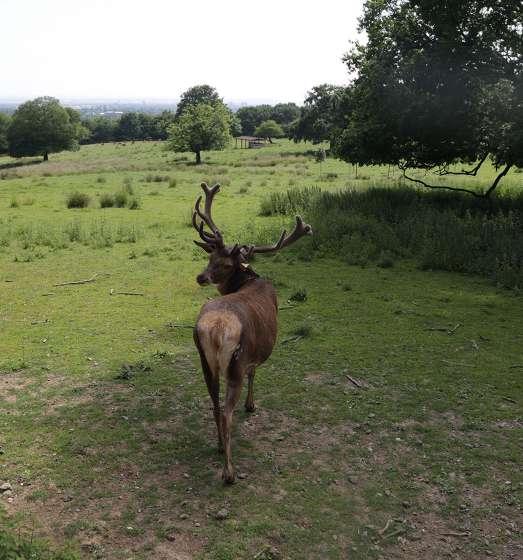
Broxhill Road, Havering-atte-Bower, RM4 1QH 01708 748646 / bedfords@essexwt.org.uk
Our new Site Manager Ben will be welcoming visitors to Bedfords Park Nature Discovery Centre this summer. Enjoy delicious ice cream in the spacious café with stunning views of red deer and our glorious landscape. Come say hello and enjoy the warm welcome, whether you’re alone or with friends and family. Ben Stokes, Site Manager.
Belfairs
Belfairs Nature Discovery Centre
Eastwood Road North, Leigh-on-Sea, SS9 4LR 01702 477467 / belfairs@essexwt.org.uk
We are celebrating 10 years young at Belfairs Woodland Centre this year, so watch out for fun family activities this summer!
In September, our seventh annual Dog Show will take place, plus our 5km Fun Run later in the month. Full details will be on our Facebook page very soon! Facebook page: www.facebook.com/EWTBelfairs Greg Borgartz, Site Manager.
Fingringhoe Wick
Fingringhoe Wick Nature Discovery Park
South Green Road, Fingringhoe, Colchester, CO5 7DN 01206 729678 / fingringhoe@essexwt.org.uk
Look out for weekly trails and activities for kids this summer. Keep an eye out for dragonflies and butterflies, and learn how to identify them with our many workshops. Join the Birlore workshop on 1 July, and the Reuse and Recycle day on 2 July, where you can shop recycled arts and get items repaired. Verity Hales, Site Manager.
your nearest centre www.essexwt.org.uk/visit/centres Nature Discovery Centres 42 WILD Summer 2023 |
Discover
Bedfords Park
Photo: Peter Bowden
Speckled wood photo: Chris Gomersall/2020VISION
Hanningfield Reservoir
Hanningfield Reservoir Nature Discovery Park
Hawkswood Road, Downham, Billericay, CM11 1WT 01268 711001 / hanningfield@essexwt.org.uk
Summer is a wonderful time to take in what Hanningfield has to offer. Enjoy a relaxing walk through the ancient woodland, enjoy the wildflowers that are attracting an abundance of butterflies and other pollinators at this time of year. Visit the ponds to watch the dragonflies and damselflies. For information about all events at Hanningfield please look on www.essexwt.org.uk/events. Michelle Rayner, Assistant Centre Manager.
Ingrebourne Valley Nature Discovery Centre

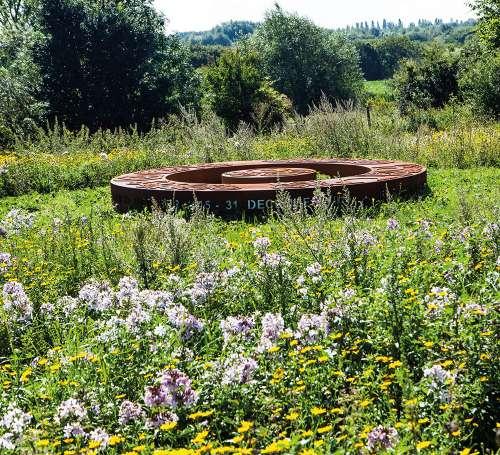
Hornchurch Country Park, Squadrons Approach, Hornchurch, RM12 6TS 01708 520364 / ingrebourne@essexwt.org.uk
Come to the Ingrebourne Valley this summer to see azure blue demoiselle’s and emerald green dragonflies. Enjoy the blooming grassland with a summer picnic and traditional games. Check out the local military history events, explore the former R.A.F. Aerodrome, and see the Memory Booth with artefacts and memorabilia. There are plenty of children’s activities, visit our website for more information and bookings. Hope to see you soon!
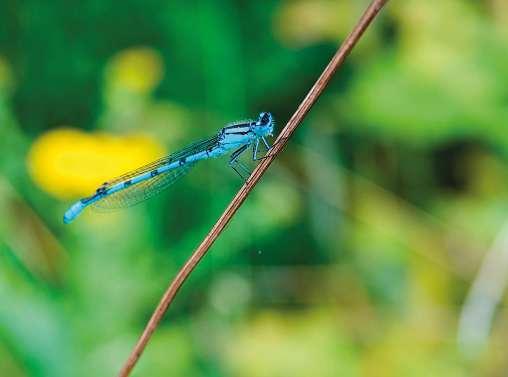
Kate Tyler, Assistant Centre Manager.
Thameside Nature Discovery Park
Mucking Wharf Road, Stanford-le-Hope, SS17 0RN 01375 643342 / ttnp@essexwt.org.uk
Thameside offers everchanging views from our rooftop. Summer brings a burst of colour from the Coronation Meadow, skylarks sing above, and goldcrests hop on the handrail. Visit during rising tide to see waders. Wonderful new additions include the “Rupert” picnic boat and a labyrinth for mindfulness. Lots of ways to enjoy the outdoors, as well as photo opportunities!
Jimmy
Allan,
Site Manager.
Nature Discovery Centres 43 WILD Summer 2023 |
Ingrebourne Valley
Follow each of our Nature Discovery Centres on Facebook
Photo: Peter Bowden
Thameside
What’s on this
Summer
Great British summertime has arrived. Lean in close to hear the soothing exhales of our woodlands, watch as meadows of colourful wildflowers ebb and flow in the warm breeze and feel the cool splash of the sea as it chases you up the shore. This is the time of year when our wild spaces really come to life. The sun greets us earlier, and stays until late at night, giving us longer and warmer days, perfect for those exhilarating summer adventures. It’s the season of rockpooling on jagged shores, stargazing on crystal clear nights and getting up close and personal with your garden pond. Pull up a chair and execute the perfect pond stake out. Try not to blink or you might miss the blue flash of an emperor dragonfly, pond skaters skimming across the surface or teenage toads emerging from the water for the very first time.
Fledglings are taking their first flights, common seals are basking in the sun and grass snakes are cooling off with a swim. For most, summer is a time for fun and games. Our pollinators, however, are hard at work during their busiest time of the year, rejuvenating our landscape. The scents of honeysuckle and lavender waft through the air inviting the busy bees and beautiful butterflies to descend upon them. Still sleepy ladybirds fly haphazardly through the air whilst delicate damselflies dart past at record breaking speed. Then, as most insects rest their wings for the night, the moths awake, ready to take over for the nightshift. With thousands of insect species in Essex, make sure you keep an eye out for our fluttery friends this summer.
Become a Butterfly Seeker this summer by submitting your butterfly sightings! Your records will help us do more for butterflies in Essex.
Find out how to take part at www.essexwt.org.uk/butterfly-seekers
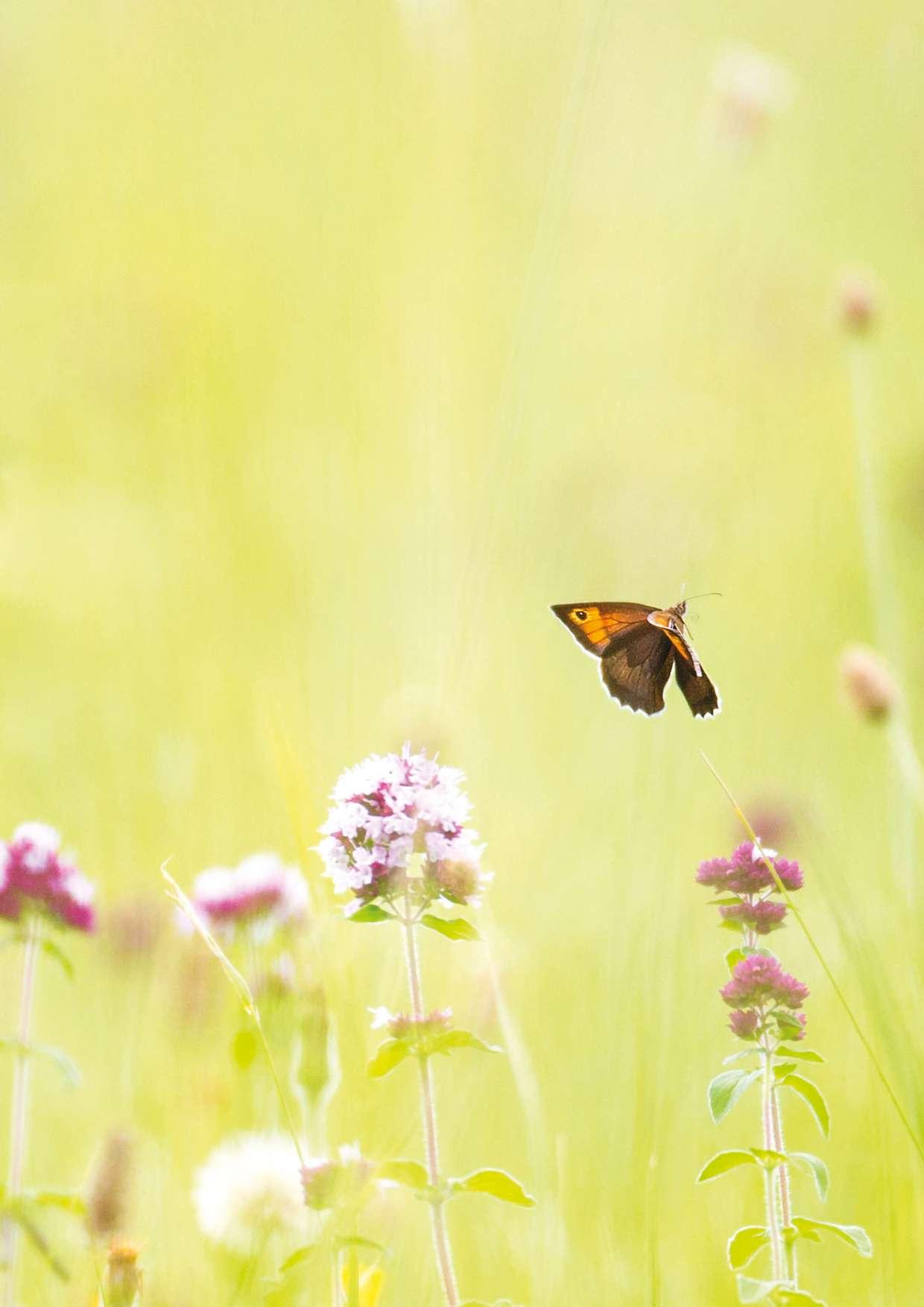
44 WILD summer 2023 | Discover things to do and spot in JUNE, JULY and AUGUST >>>
What’s on this summer
Summer Butterflies to spot

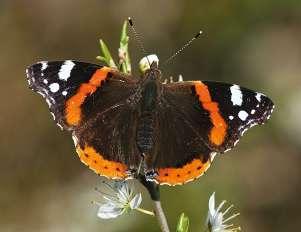



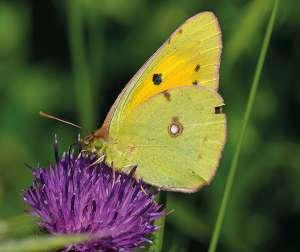


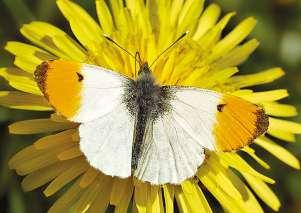
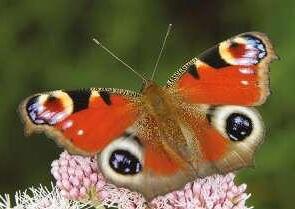

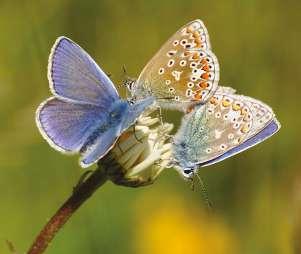
We’ve created a handy checklist to cut out and keep, featuring some of the most beautiful butterflies. Challenge your friends and see how many you can tick off whilst enjoying the summer sunshine.

45 WILD summer 2023 |
Meadow brown Peacock
Orange tip
Brimstone
Painted lady
Clouded yellow
Sheepleas flowers background photo: Jon Hawkins Surrey Hills Photography
Gatekeeper: David Longshaw, common blue: Janet Packham, comma: Vaughn Matthews, small copper: Andrew Kerr, red admiral: Guy Edwardes/2020VISION, brown hairstreak: Philip Precey,
What’s on this summer
meadow brown: John Bridges, peacock: John Bridges, orange tip: John Bridges, brimstone: Jim Higham, painted lady: John Bridges, clouded yellow: John Bridges
Common blue Comma
Small copper Red admiral Brown hairstreak
Dates for your diary
SCULPTURE TRAIL

• Saturday 1 AprilSaturday 30 September
• 10am - 4pm
• Fingringhoe Wick Nature Discovery Park, Colchester, CO5 7DN
In collaboration with the Colchester Arts Society, we are thrilled to announce our first sculpture trail/exhibition. Wander around for a fresh look at art in a stunning environment. Contact: 01206 729678, fingringhoe@essexwt.org.uk
WILD LIVING: BEES WALK AND TALK
• Saturday 10 June
• 1.30pm - 3.30pm
• Chafford Gorges Nature Discovery Park, Grays, RM16 7RG
A practical beginner’s introduction to the many different bees found across Essex and the UK. Contact: learncha@essexwt.org.uk
Illustrated talk
• Tuesday 13 June
• 7.30pm - 9.15pm
• Fairkytes Arts Centre, Hornchurch, Essex
Havering Local Group event. “No boat required, exploring tidal islands” an illustrated talk by Peter Caton. Contact: 01708 473927 / 07957 264240
WILD WALK AND WONDER
• Tuesday 13 June and Tuesday 20 June
• 1.30pm - 3pm
• Bedfords Park Nature Discovery Centre, Havering-atte-Bower, RM4 1QH Interactive wellbeing walks where you can discover and learn about the nature around us. Contact: learnbed@essexwt.org.uk
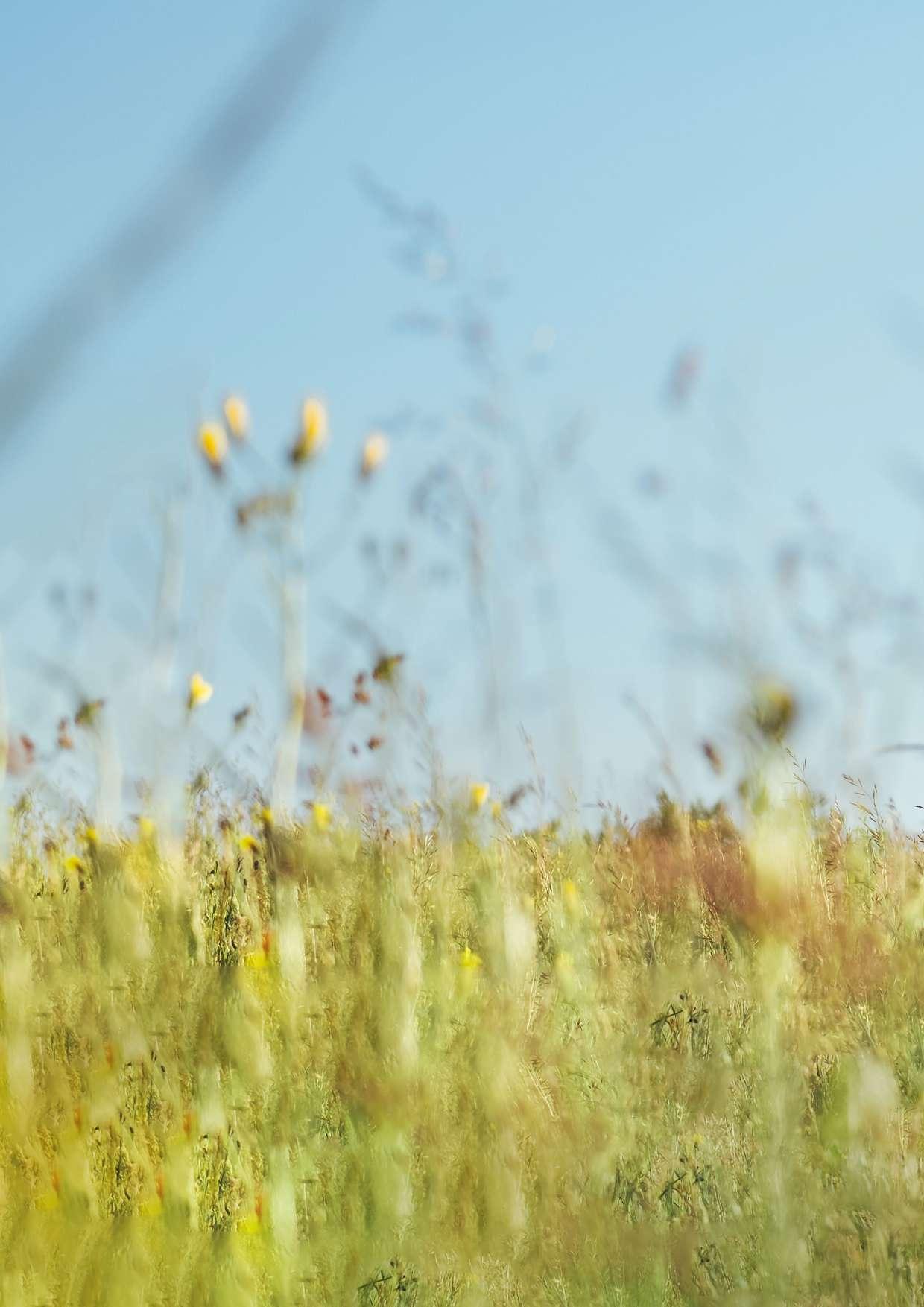
HEATH FLOWER WALK
• Wednesday 28 June
• 7pm - 8.30pm
• Tiptree Heath nature reserve, Tiptree, CO5 0PT
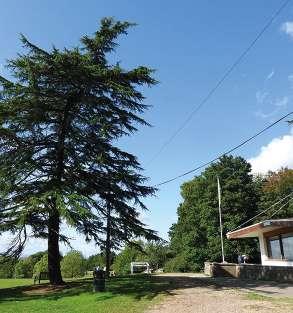
Helen Eastbrook and Steve Beckett will explore and introduce you to the special flora of the heath, including two of the three rare types of heather. Contact: 07842 110051, joanp@esssexwt.org.uk

BUTTERFLY ID WORKSHOP
• Saturday 15 July
• 9.30am - 12.30pm
• Fingringhoe Wick Nature Discovery Park, Colchester, CO5 7DN
Want to know your red admiral from a peacock? What is a comma? Join our guide Liz for a morning Butterfly ID workshop. Contact: 01206 729678, fingringhoe@essexwt.org.uk
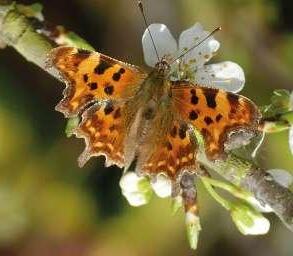
KITE FESTIVAL
• Saturday 22 JulySunday 23 July
• 10am - 4pm
• The Naze Nature Discovery Centre, Walton-on-the-Naze, CO14 8LE
Join us for an amazing weekend of kite displays by the East Anglian Kite Flyers and kite decorating workshops. Contact: 01255 679379, naze@essexwt.org.uk
GEOLOGY WALKING TOUR
• Saturday 29 July
• 2pm - 4pm
• The Naze Nature Discovery Centre, Walton on The Naze, CO14 8LE
A guided walk around The Naze with an emphasis on the unique and fascinating natural geology of the land. Contact: 01255 679379, naze@essexwt.org.uk
All events listed are correct at time of print
46 WILD summer 2023 | Summer Events and activities
Photo: Charlie Oliver
Summer Events and activities
With summer just around the corner, there’s no better time to get out and explore our beautiful nature reserves and Nature Discovery Centres. So lace up your walking boots, grab your binoculars, and join us for an unforgettable summer of wildlife discovery.

For all our events and booking, scan the QR code or visit www.essexwt.org.uk/events
Regular events for children and families:
Nature Tots
Join our weekly parent and toddler group where young children can explore, play and learn through nature, suitable for ages 18 months to 5 years.
Home Education
Our Forest School home education sessions are a series of specialised, play-based, learning activities.
SEND Forest Fun
Our regular forest outdoor learning sessions for SEND children, where they can learn bushcraft skills, enjoy making natural arts and crafts and go for a nature walk.
School holiday events
Throughout the summer holidays, we are offering a wide range of wildlife-themed events, from family activities to drop-off days at each of our Nature Discovery Centres.
Birthday parties
Are you looking for an exciting and hassle-free party with a difference? Our Nature Discovery Centres offer wildlife-themed birthday parties for all ages.
- stock.adobe.com
Child with kite photo: Soloviova Liudmyla
47 WILD summer 2023 |
Summer Events and activities
ere at The Wildlife Trusts, we know how important it is that everyone has the opportunity to get out and enjoy nature.
Across the UK, we look after around 2,300 nature reserves to help ensure that no matter where you live, you can enjoy a walk on the wild side. But nature can be sensitive. There are animals that are easily disturbed, plants at risk of trampling. Sometimes we have to impose restrictions to keep wild places wild.
Our communications recently have had a real focus on getting this message out to the public. We know our members are wildlife lovers that truly care about nature, so we wanted to highlight some of the issues that you’re helping us prevent by respecting nature reserves and the special species they protect.

Leading by example 48 WILD Summer 2023 | FAMILY WITH DOG © TOM MARSHALL
Paws for thought
Dogs are our most popular pet, with an estimated 13 million in the UK. They bring companionship and joy to their owners. They also lead people to be more active and spend more time in nature, which is great! But unfortunately for both us and wildlife, dogs and nature reserves aren’t always compatible. Even the most mild-mannered of our four-legged friends is still shaped like a predator, and that’s exactly how wild animals see them. A dog is a potential threat. Even if the dog doesn’t chase birds, squirrels, deer or other animals, its presence can cause them to stop feeding, become stressed, and even temporarily abandon a nest. Many birds nest or feed on the ground, where they’re vulnerable. When a dog is off lead and wanders away from the path, it has the potential to disturb even more wildlife.
Man’s best friend can directly influence wild places too. Chemicals in flea treatments can leach into ponds, lakes, and rivers, harming wildlife. And dog poo isn’t just unpleasant to stand on, it also adds nutrients to the soil. Wee does the same. This can be disastrous for rare plants that are adapted to low nutrient levels. As the soil nutrients increase, these plants are crowded out by nutrient-loving plants like nettles. A recent study on Belgian nature reserves estimated that each year dogs add an average of 11kg of nitrogen and 5kg of phosphorous per hectare. Picking up the poo can reduce these numbers dramatically.
Slim pickings
Last autumn some Wildlife Trusts had issues with gangs of foragers sweeping through nature reserves, gathering bags of fungi. Wild foraging can be fun and useful (if you know what’s safe to eat), but it can lead to problems for wildlife and wild places if done too frequently. Picking mushrooms isn’t generally bad for the fungus itself, as they’re seasonal fruiting bodies, but lots of people roaming in search of them can lead to plants being trampled and ground compacted. There are plenty of animals that feast on fungi too, from flies to mice and deer — so it’s important that some are left for nature’s foragers.

The heat is on
The Wildlife Trusts’ Changing Nature report highlighted that climate change is increasing the risk of wildfires on our nature reserves. Hot, dry springs and summers turn heathlands, grasslands and forest floors to kindling. A single discarded cigarette or a barbecue is all it takes to ignite a blaze that can destroy acres of vital habitat for wildlife. Rare reptiles, protected plants, endangered insects, and ground-nesting birds can all be lost. But these fires don’t just harm wildlife, they also release huge amounts of carbon into the atmosphere and damage the ability of wild places to help fight the climate crisis. So thanks for packing a picnic instead and helping us spread the message.
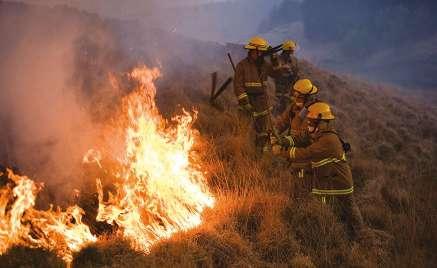

We hope this helps explain the need for restrictions in some of our wild places. Many Wildlife Trust nature reserves welcome dogs on leads, but some are so sensitive they need to be dog free entirely — so please check before you travel. Thank you for helping keep our wild places safe and setting a great example for other visitors..
 Ground nesting birds like nightjars are especially vulnerable
Ground nesting birds like nightjars are especially vulnerable
Leading by example 49 WILD Summer 2023 | FIGHTING FIRES © JASON SMALLEY, NATUREPL; NIGHTJAR © DAVID TIPLING/2020VISION; BIRCH BOLETE © AMY LEWIS
Fungi can be a feast for wildlife
A bee, or not a bee, that is the question!
Does the difference between wasps and bees make your head buzz round? Bees and wasps are often confused because of their similar colourations. Here’s our handy guide to finding out which busy beasts are friends or foes this summer.
Honeybee
These are social insects that live in hives made up of thousands of workers. They have a distinctive barrel-shaped body and don’t have a thin middle section like you see in wasps. Large, hairy eyes and hairy bodies help them carry lots of pollen as they move from flower to flower. Honeybees do sting occasionally, but only if they feel threatened. Remember, honeybees are defensive, not aggressive.
Bumblebee
The most common of this species is the common carder bee. Fluffy brown and orange bodies contrast to darker bands around their abdomen. The white-tailed bumblebee is identified by its lemon-yellow body bands and bright white ‘tail’. Similarly, the buff-tailed bumblebee has a buff-coloured ‘tail’ with darker yellow markings. Bumblebees rarely sting and your chance is reduced even further by avoiding provoking them. Be calm if you see a bumblebee, do not wave your arms or flap!
Solitary bee
Bees that do not live in colonies but live alone. Mason bees, wool carder bees, leafcutter bees and mining bees are all types of solitary bee – and all have slightly different variations of colour and shape. You can tell they aren’t wasps by looking at their bodies: are they hairy and furry? Solitary bees are fantastic pollinators, and they are the least likely to sting. As they don’t have honey to protect, they are relatively harmless – and males generally have no sting at all!
Wasp
Are they bright yellow with black stripes? Are they smooth and less hairy? Are they attracted to sweet foods? Do they have a high-pitched buzz? Most likely, you are looking at a wasp. The common wasp and German wasp are the abundant species in the UK. Wasp stings tend to be more painful than bees, giving them a bad reputation. However, wasps will usually only attack if they feel threatened. There are over 7,000 wasp species in the UK and they are important for balancing our ecosystem as they keep our insect population in check.
Hornet
The European hornet is the UK’s only native hornet species, and the largest of our social wasps. Their bodies are yellow with dark brown markings, but their sting is more pronounced than common wasps, despite being less aggressive. They pose no threat to us. However, Asian hornets, a smaller, invasive species, threaten the UK’s honeybee population – just one hornet can kill up to 50 bees per day. Their sting is long enough to puncture thick clothing, and they are fiercely defensive of their nests. Their bodies are almost entirely dark, with fine yellow strips, whereas European hornets’ bodies are predominantly yellow.
You better bee-lieve it! In the UK, we have over 240 species of solitary bee and 24 species of bumblebee!
50 WILD Summer 2023 The difference between wasps and bees |
Coat / colour Size
• Furry short hair
• Black or brown intermixed with amber
Honeybee
• Furry long hair
• Black and yellow
Bumblebee
• Furry short hair
• Vary in colour
Solitary bee
• Little or no hair
• Bright yellow and black
Wasp Hornet
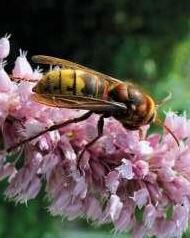


• Some hair
• Chestnut brown and yellow
• Queen: 1.6 - 1.8cm
• Worker: 1.2 - 1.4cm
Nest Food
• Hollow trees
• Roofs
• Wall cavities
• Nectar from flowers
Traits
• Gentle natured
• Dies after stinging
• Swarms in spring and summer
• Queen: 2 - 3cm
• Worker: 0.8 - 2cm
• Cavities in soil
• Nectar from flowers
• Gentle natured
• Reluctant to sting
• Does not swarm
• Seen from spring until autumn
• Various sizes
• Generally smaller than honeybees

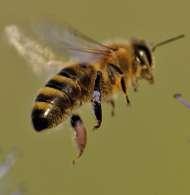
• Queen: 2cm
• Worker: 1.2 - 1.8cm
• Mortar between bricks
• Sandy soil
• Soft cement
• Attics
• Wall cavities
• Hollow trees and bushes
• Nectar from flowers
• Gentle natured
• Rarely stings
• Does not swarm
• Seen from early March
• Insects
• Sugary drinks
• Food waste
• Aggressive
• Stings when threatened
• Does not swarm
• Seen in late summer
• Queen: 3.5cm
• Worker: 2 - 3cm
• Tree trunks
• Hollow walls
• Attics
• Mainly insects
• Only stings when provoked
• Can bite and sting
• Does not swarm
• Seen from early March
51 WILD Summer 2023 The difference between wasps and bees |
this checklist nearby over the summer to check what you’ve got in your garden.
European honeybee photo: Chris Gomersall/2020VISION, buff-tailed bumblebee photo: Vaughn Matthews, patchwork leafcutter bee photo: Ryan Clark, common wasp photo: Mike Snelle, queen European hornet photo: Nick Upton/2020VISION.
Keep
We travel back to...
What was happening globally in 1970:
• The Beatles disbanded with Paul McCartney announcing his departure.
• Apollo 13 launched.
• The Vietnam War, a conflict between Vietnam, Laos and Cambodia, was in its 15th year.
• The legal age of adulthood was reduced from 21 to 18.
• In wildlife, the Conservation of Seals Act was published, to protect and conserve seals in the UK.
Autumn 1970, when Essex Wildlife Trust was known as Essex Naturalist’s Trust,

would become WILD magazine was at this time an illustrated bulletin.
Conservation of roadside verges
In the Spring Bulletin we asked members to notify us of any roadside verges known to them which, in their opinion, needed protection, notably in the form of a restricted cutting programme, because of their plant-life.
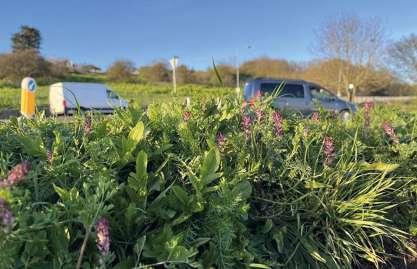
The response to this request has been very poor: in fact, only two lengths of verge have so far been suggested. However, the General Secretary and Dr. K.J. Adams have surveyed a substantial area in the NW. of the county and have noted several verges which need protection on account of their rich plant-life, as well as some chalk cuttings which support a pure “chalk” flora, including a proportion of rare species. If this very important work of preserving the native flora of our roadsides is to be accomplished before it is too late, it is imperative that we have the help of many more people with a knowledge of botany.
Remember that in preserving roadside verges we are saving what are in many cases the last remnants of typical meadowland flowers which are now just “hanging on”, and that unless we act quickly to prevent indiscriminate cutting on their sites they will be lost to the county for ever.
This article, written 53 years ago, highlights the importance of roadside verges for wildflowers, insects and other species. To this day, the Trust continues to work with the public on many citizen science campaigns, and it is this collaborative spirit that allows us to preserve green spaces, no matter how big or small.
Since last year, Urban Wildlife Champions have been leading their own wildlife-friendly projects in local communities, supported by the Trust. We now have 23 champions, and many work on protecting and restoring roadside verges across Essex, such as Saffron Walden, Thorpe Bay and Hatfield Peverel.
See the action that Urban Wildlife Champions have been taking for wildlife across Essex and discover how you can become one at www.essexwt.org.uk/urban-wildlife-champions or scan the QR code.
52 WILD Summer
| Grass
2023
roots Time Tunnel
Hog’s fennel on Skipper’s Island
...to give you a glimpse of our past and see what was happening at the Trust.
and the beginnings of what
Happy, healthy and hungry to learn.
Welcome to the Nature Nursery. We offer quality childcare for 2-5 year-olds based on learning through nature.
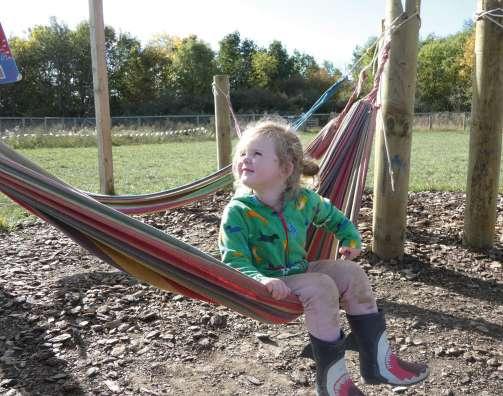
Set in the grounds of Abbotts Hall near Colchester, where children can enjoy both freedom and security. Our outdoor nursery is run by early learning experts at Essex Wildlife Trust, the most experienced provider of outdoor education in the county.


Come along and experience a morning at our outdoor Nature Nursery. Take a look at our upcoming open days and book a spot:
www.naturenursery.org.uk
53 WILD Summer 2023 | Grass roots Play Discover Learn Play Discover Learn Play Discover Learn Play Discover Learn
Nature Nursery is
part of:
Registered Charity Number 210065
How is your general knowledge on wildlife and the wild places of our country? Test yourself with our nature crossword.
Wildlife fun facts...
Billie’s Wildlife Crossword

Clues Across
5 A slender insect related to dragonflies, typically resting with their wings folded back along the body. (9)
6 Which bird has a characteristic ‘teacher teacher’ call? (5,3)
8 Which bird is the largest bird of prey in the UK, with a wingspan of over 2 meters? (11,5)
9 Which bird is the largest wading bird in Europe, characterised by a long, downward curved beak? (6)
10 Which bioluminescent insect has ‘worm’ in its names despite being a beetle? (4,4)
12 What name is given to a young swan? (6)
Clues down
1 Which wildflower is also known as Narcissus, after a Greek Myth? (8)
2 Which fungus is so named due to its appearance resembling that of a raw cut of meat? (9)
3 The second largest fish in the world, which can be spotted around the coast of Britain. (7,5)
4 What is a common name given to an otter’s den? (4)
7 What is the name for an area where saltwater from the ocean mixes with freshwater? (7)
11 Which marine species can filter 1.3 gallons of water per hour? (6)
The answers will be revealed in our Autumn 2023 edition of WILD
Fancy feet
Many butterflies use their feet to taste, this can tell them whether the leaf they are sat on is good to lay eggs on for their caterpillar’s food or not.

Solar-flowered
Daisies get their name from being the ‘days-eye’, since they open and close with the rise and setting of the sun.
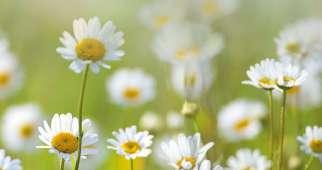
Quirky drinkers
Frogs drink through their skin, using a special area known as the ‘drinking patch’.

54 WILD summer 2023 | Wildlife quiz time
Answers from Spring 2023: Across: 5. Thameside 6. Dormouse 7. Little tern 7. Snowdrop 10. Abberton 11. Boar 12. Stoat Down 1. Sloe 2. Wood 3. Kit 4. Daddy longlegs 8. Red kite 4. March
Frog photo: Peter Cairns/2020VISION, ox-eye daisy photo: Jon Hawkins –Surrey Hills Photography, brimstone photo: Heidi Morris
2 3 1 4 9 5 12 11 8 7 10 6
1 3 4 5 2 6 7 8 9 10 11 12


Give the gift of nature
When you adopt a species through Essex Wildlife Trust, you are helping us to continue vital conservation work, protecting wildlife and wild places in Essex.
Adopt an animal for yourself, or send it as a gift to a loved one. Visit www.essexwt.org.uk/ adopt-species or scan the QR code above to choose your species.
Keeping owls on the prowl
An elusive bird of prey that roams the open space of the countryside, barn owls need your help. These owls have characteristic heart-shaped faces, cloud-like white chests with mottled brown and grey feathered wings on their back.
In a prickle
Did you know, hedgehogs can roam over 2km in one night? Despite their spiked armour, our nature neighbours aren’t as tough as they seem. In reality, these long-snouted softies are facing rapid decline, but it’s not too late to give them a helping hand.
Hare today, gone tomorrow
This nimble and swift creature has an impressive sprinting speed of 45mph, but can’t outrun the pressures facing wildlife without your help. Ensure that we can enjoy the sight of black-tipped elongated ears hopping through farmland and woodland for years to come.
Love Essex • Love Wildlife Registered Charity No. 210065.

























 Lauren Cosson Communications Officer
Lauren Cosson Communications Officer




 Bailey Tait Campaigns & Advocacy Manager
Bailey Tait Campaigns & Advocacy Manager




 Karen McKay Education and Community Officer
Karen McKay Education and Community Officer

 Karen Dixon Corporate Coordinator
Karen Dixon Corporate Coordinator















































































































































